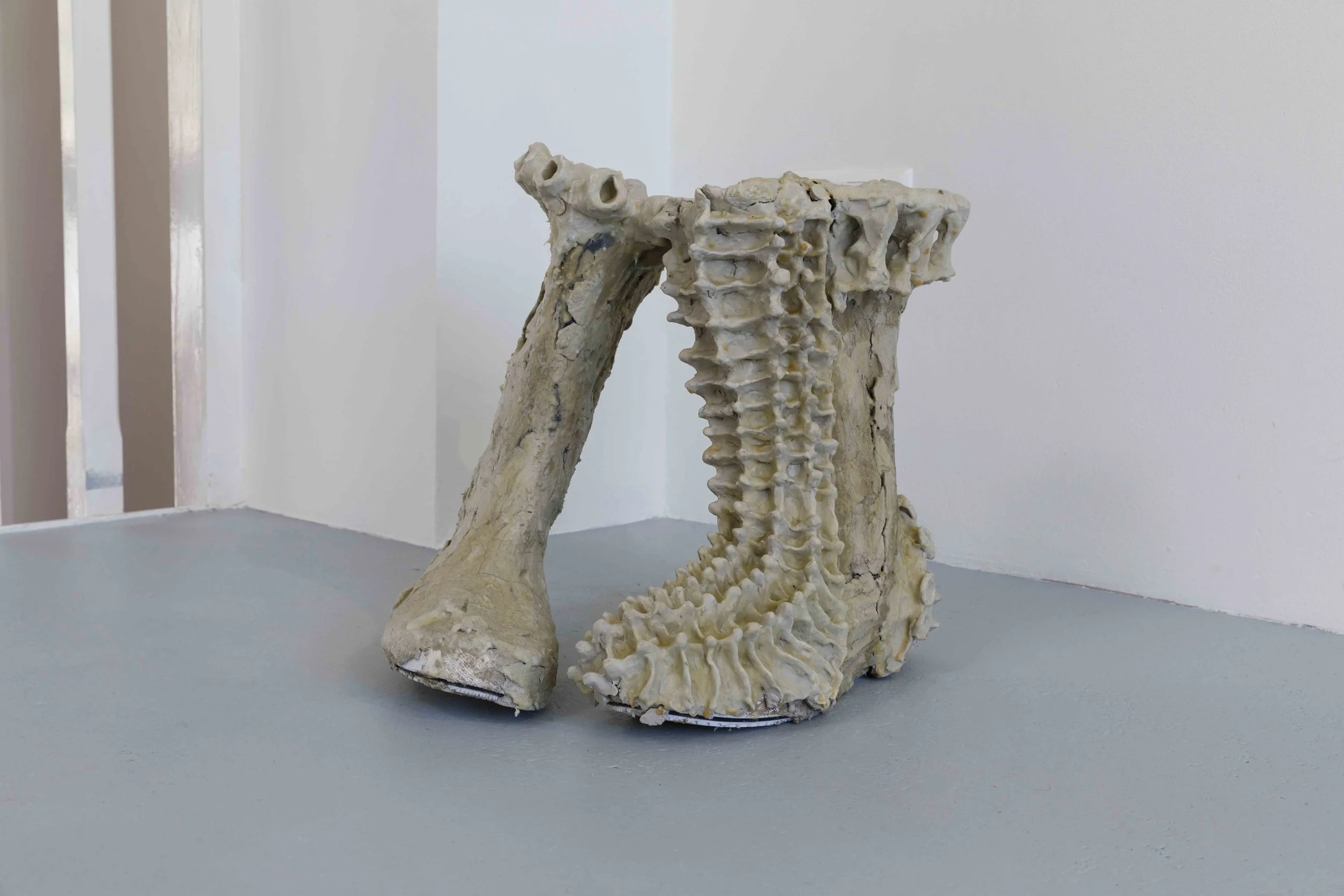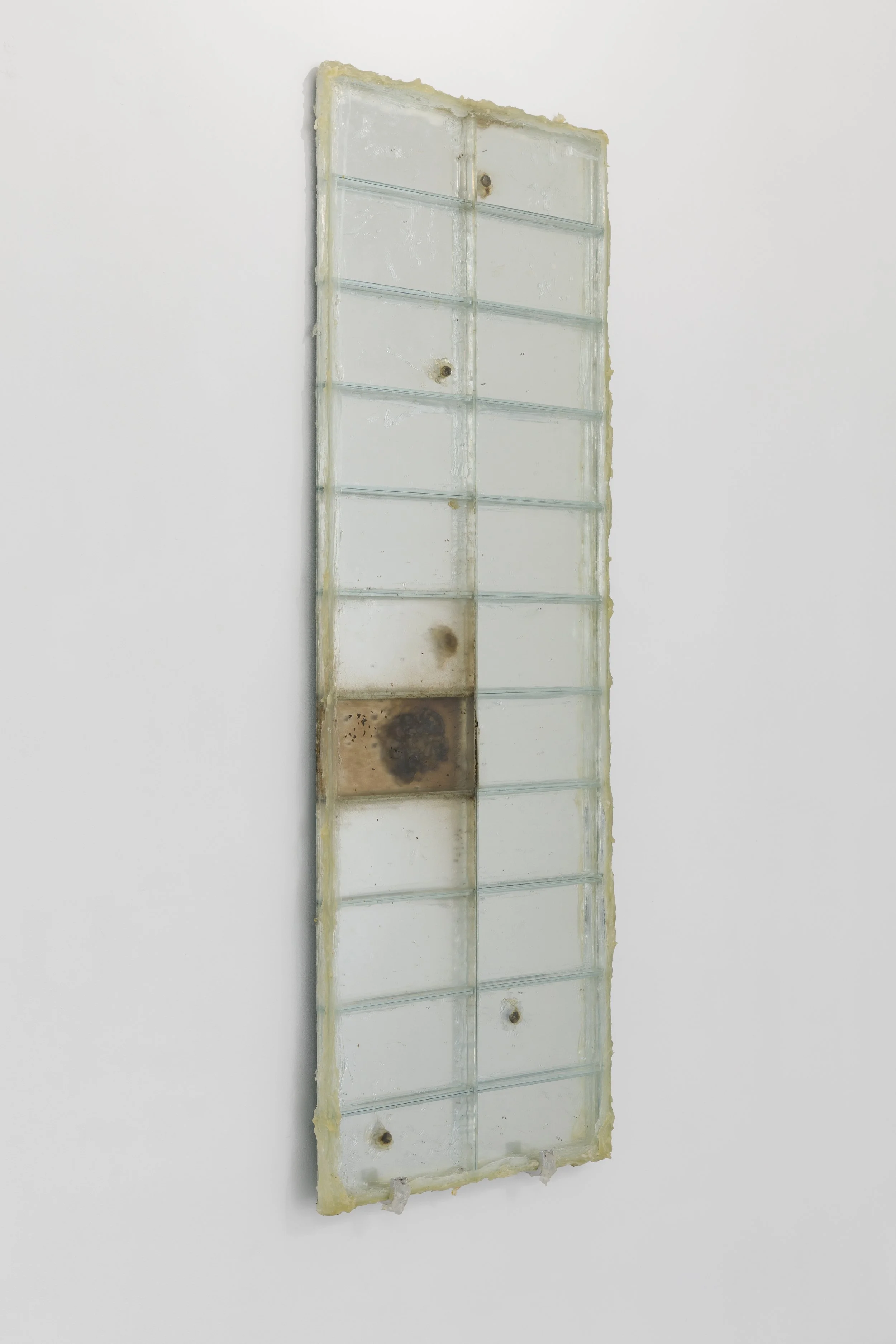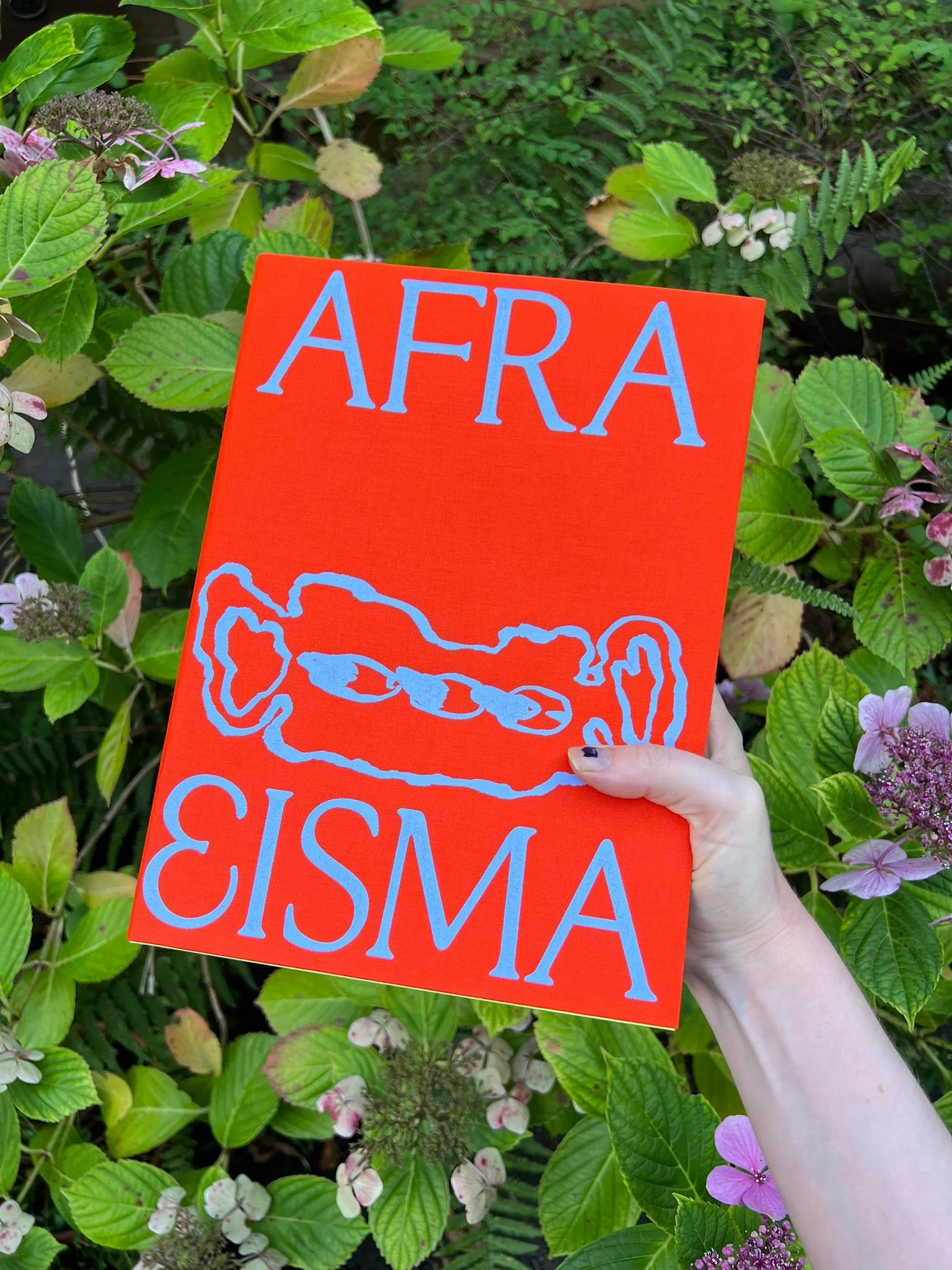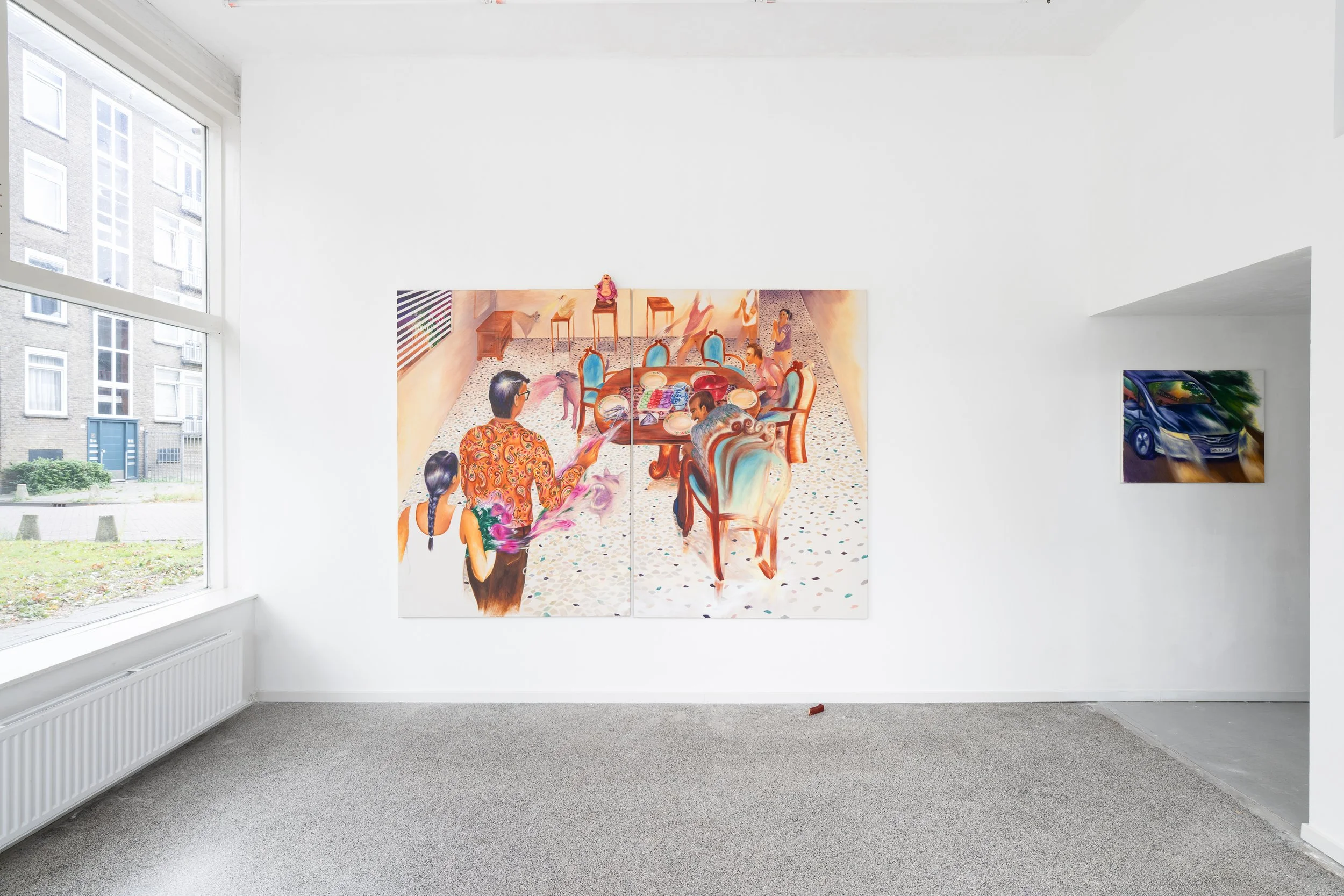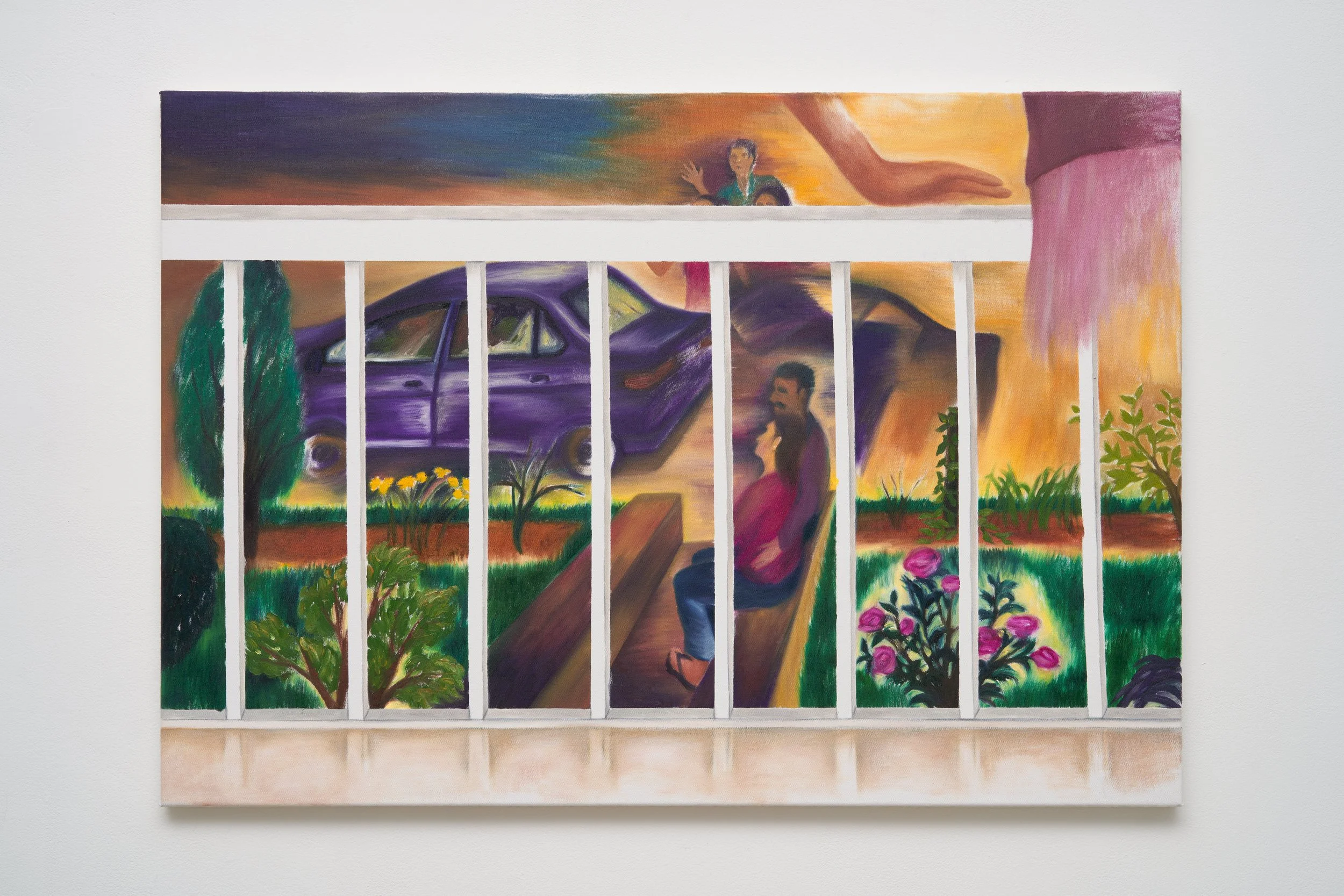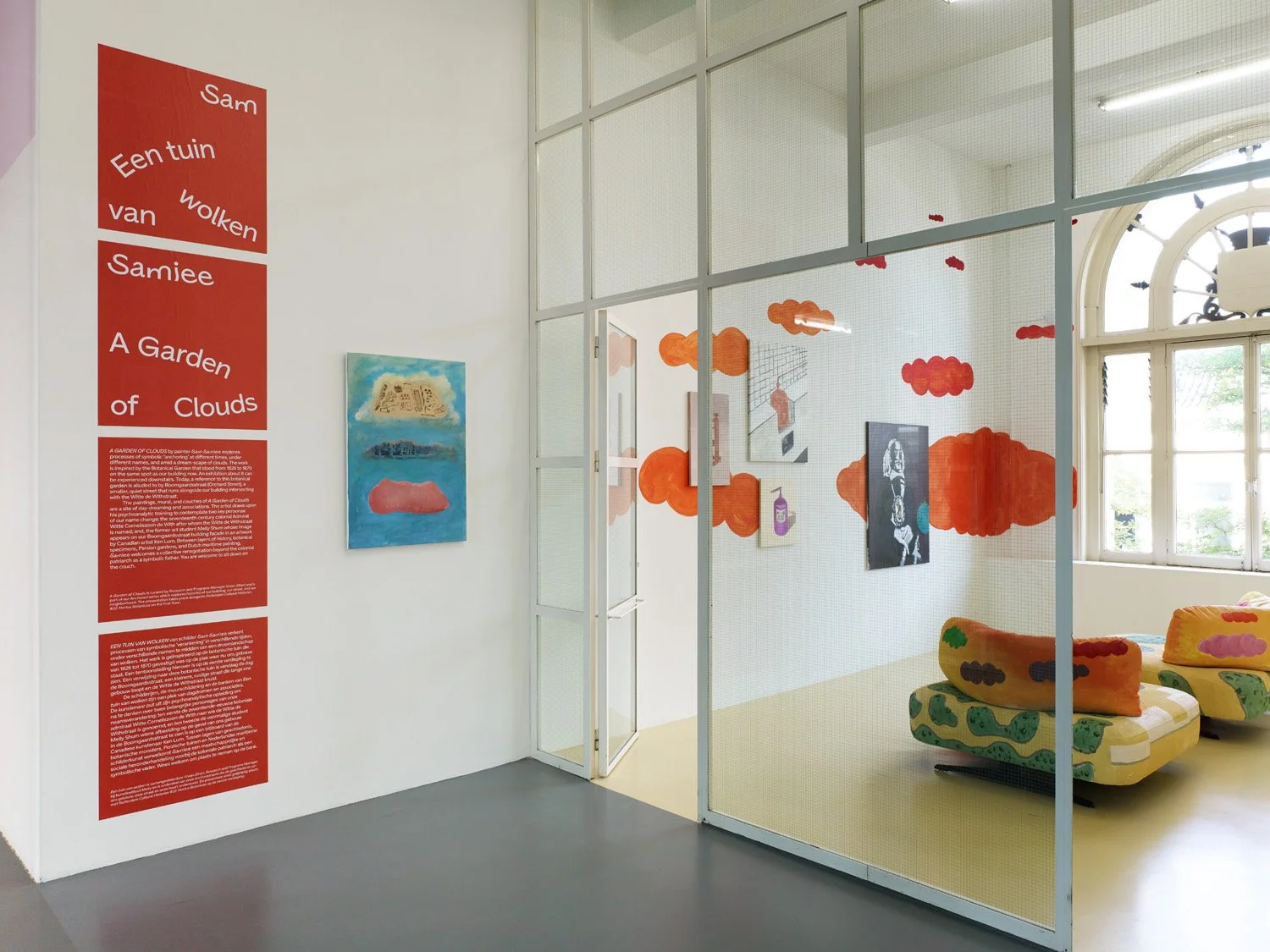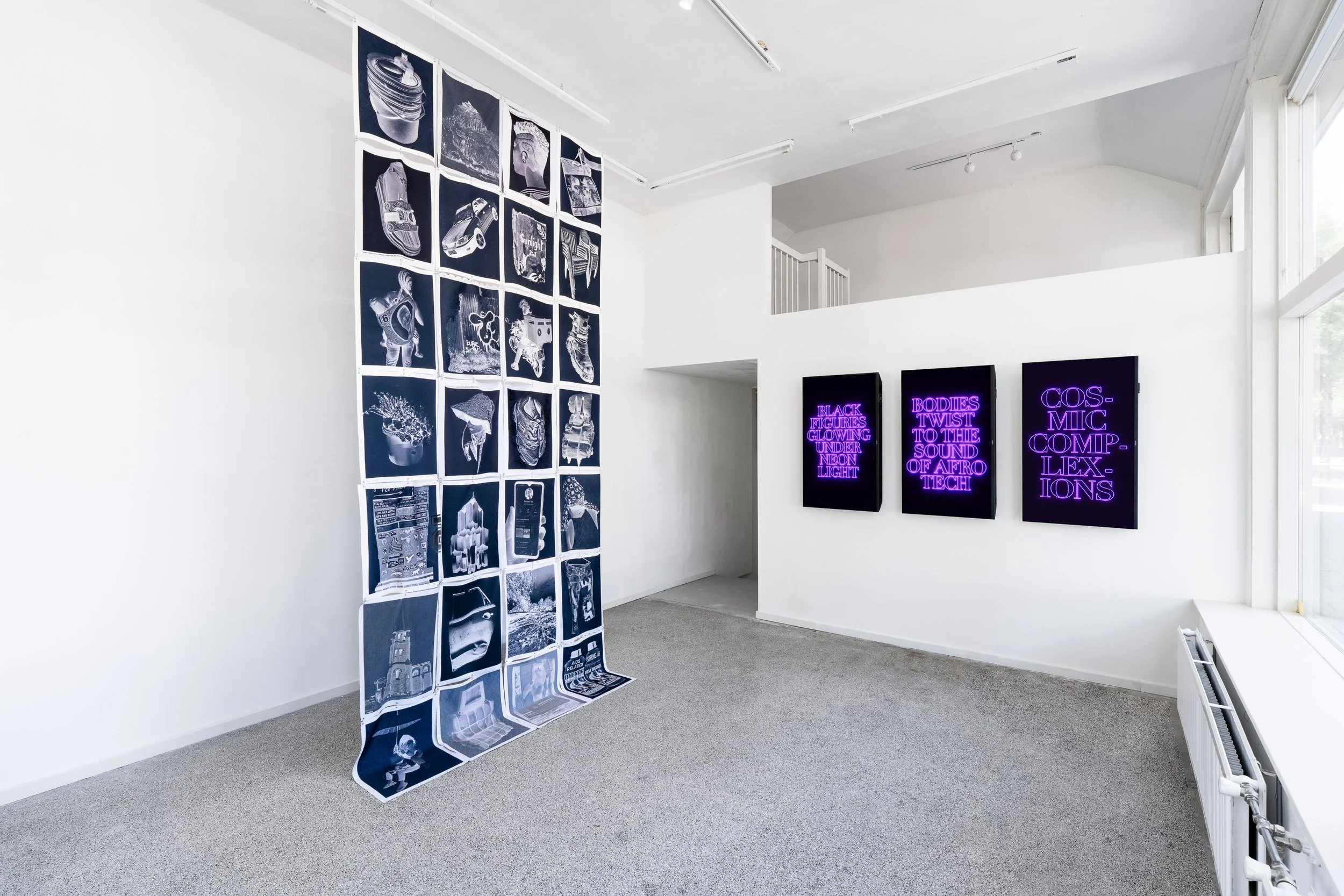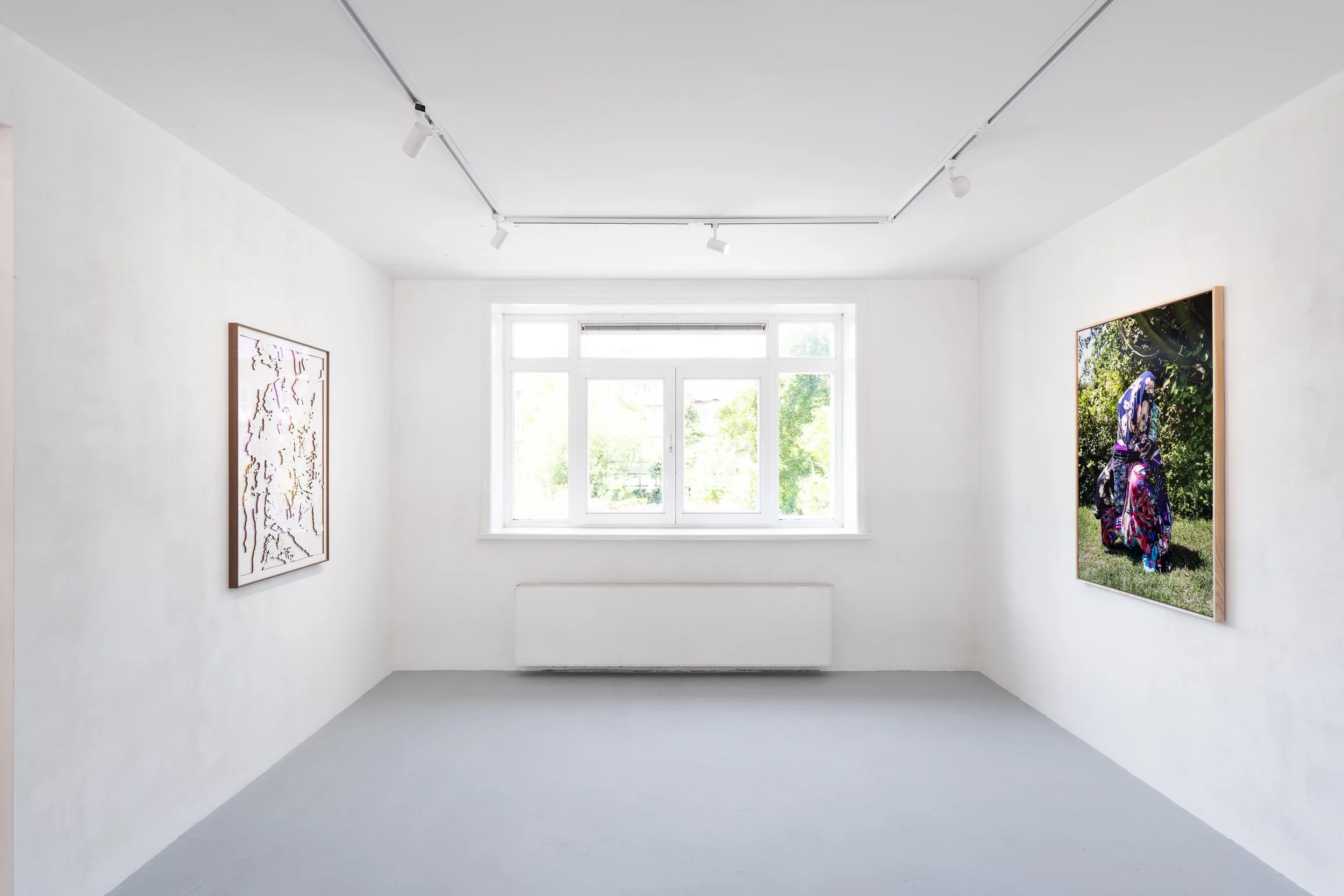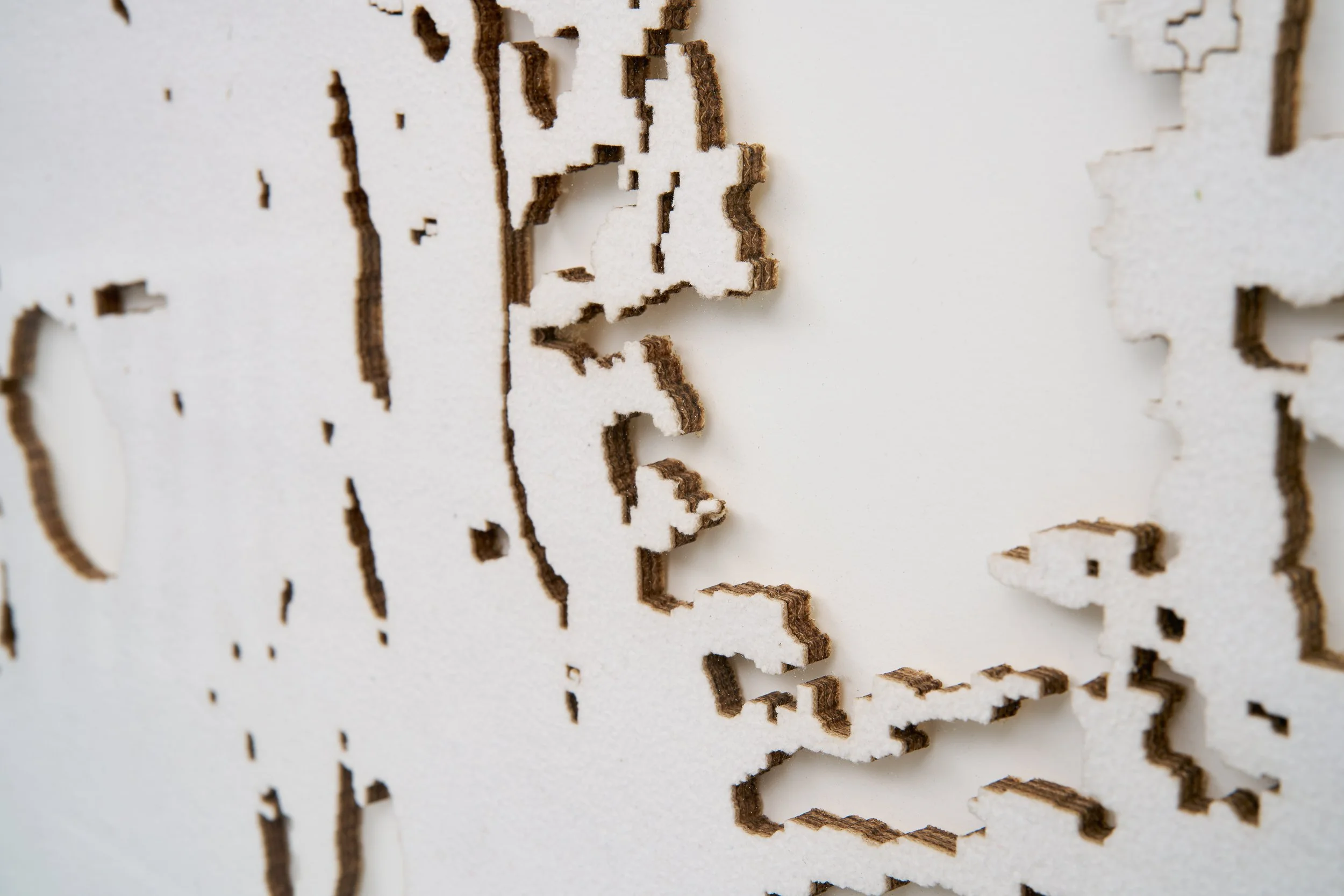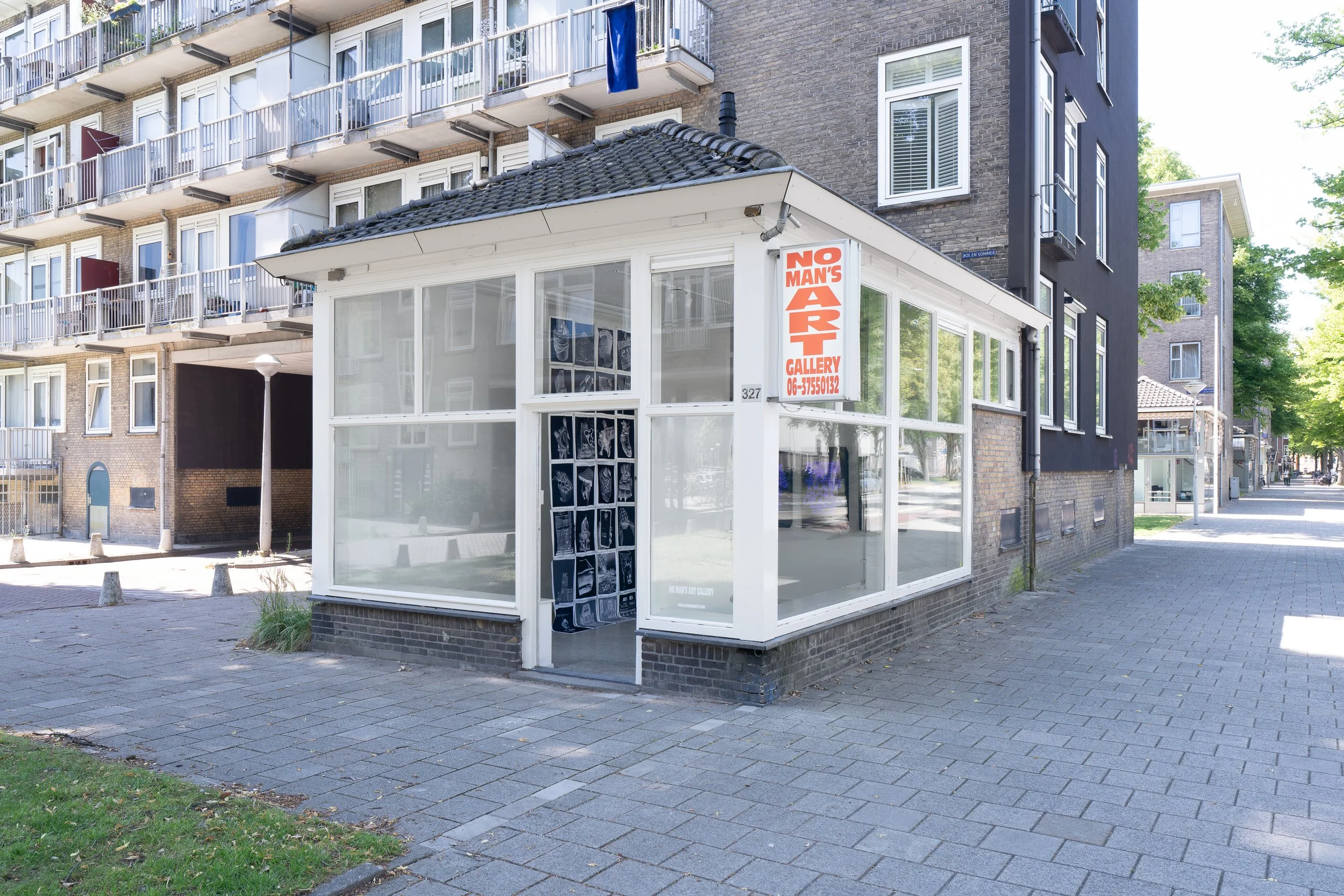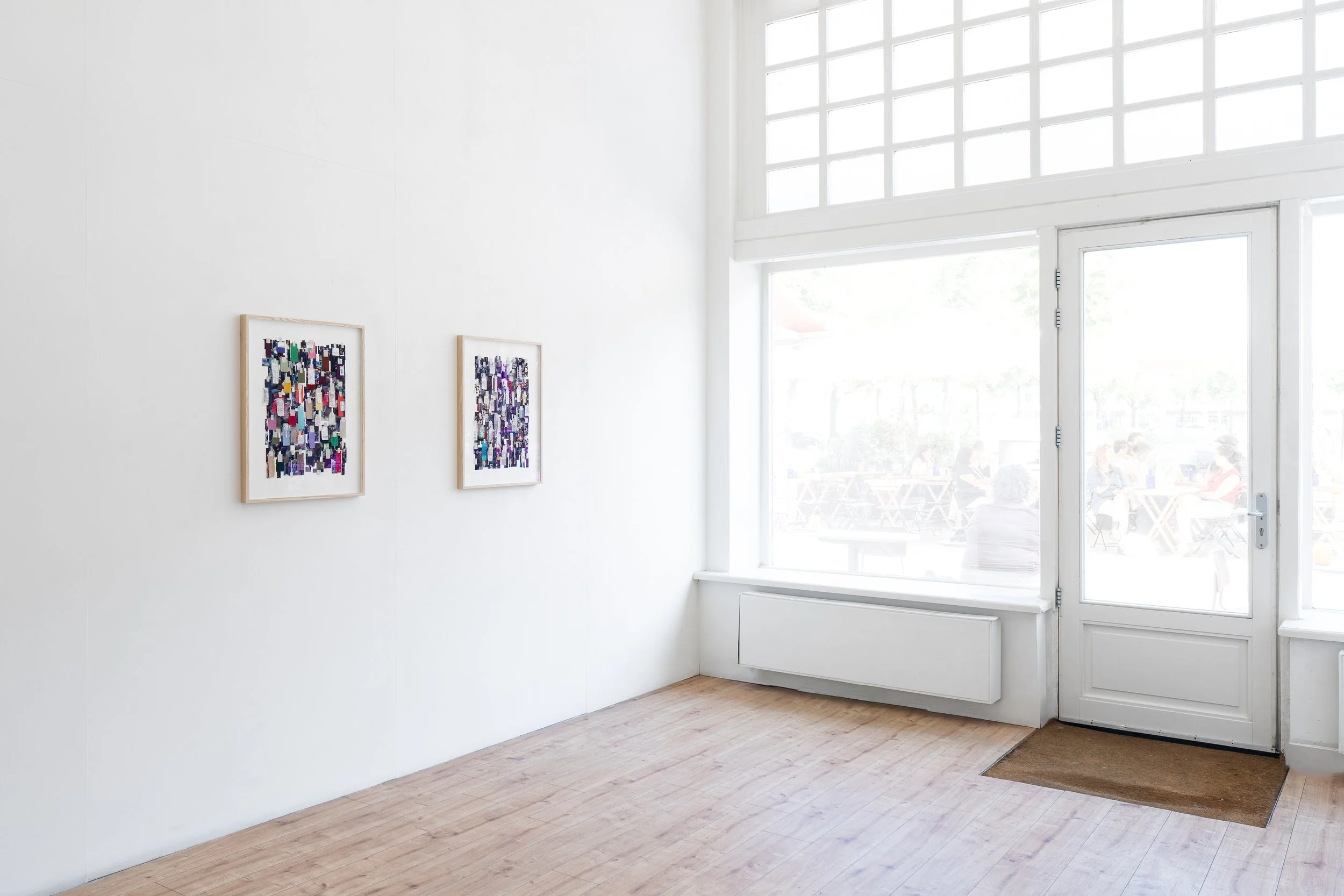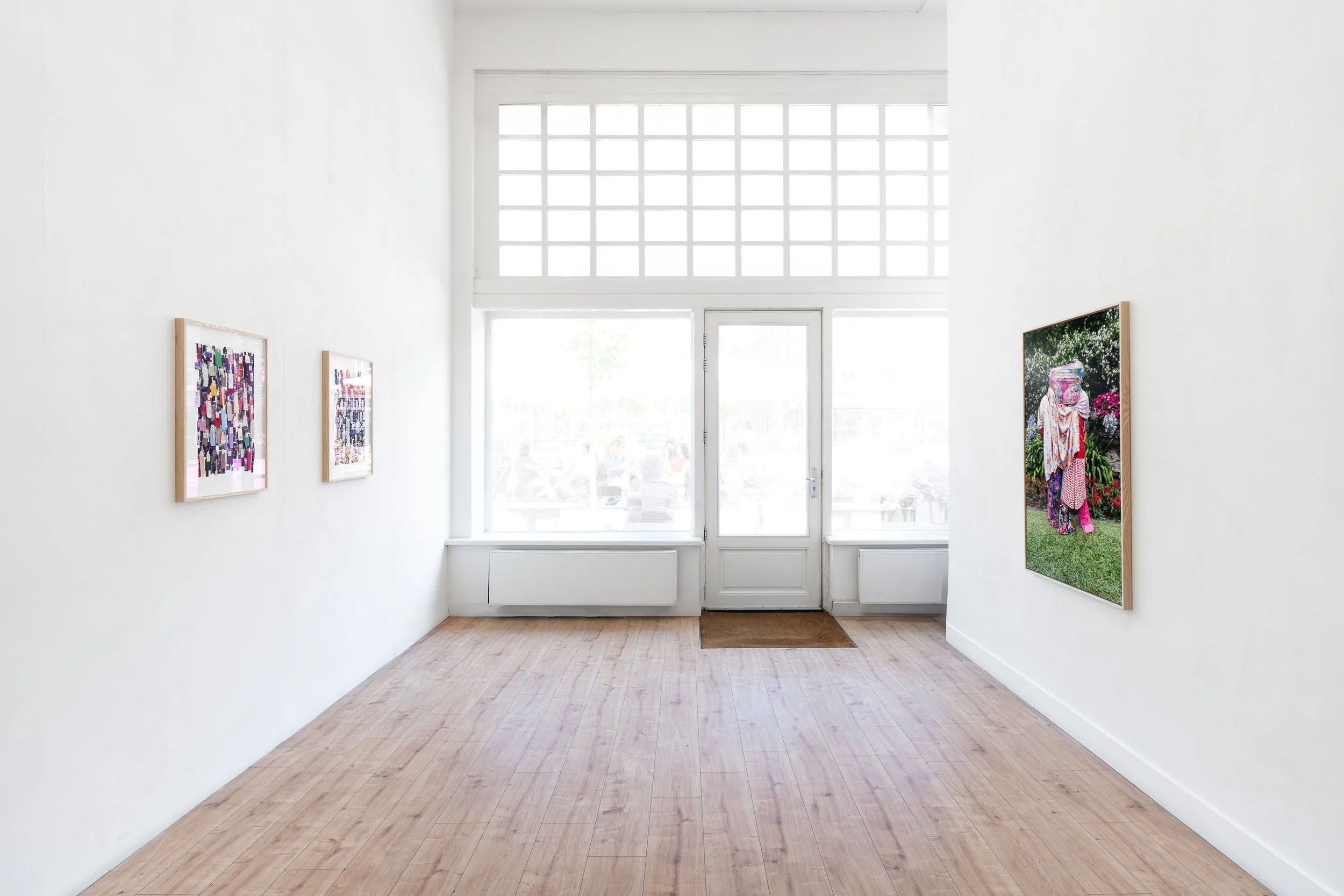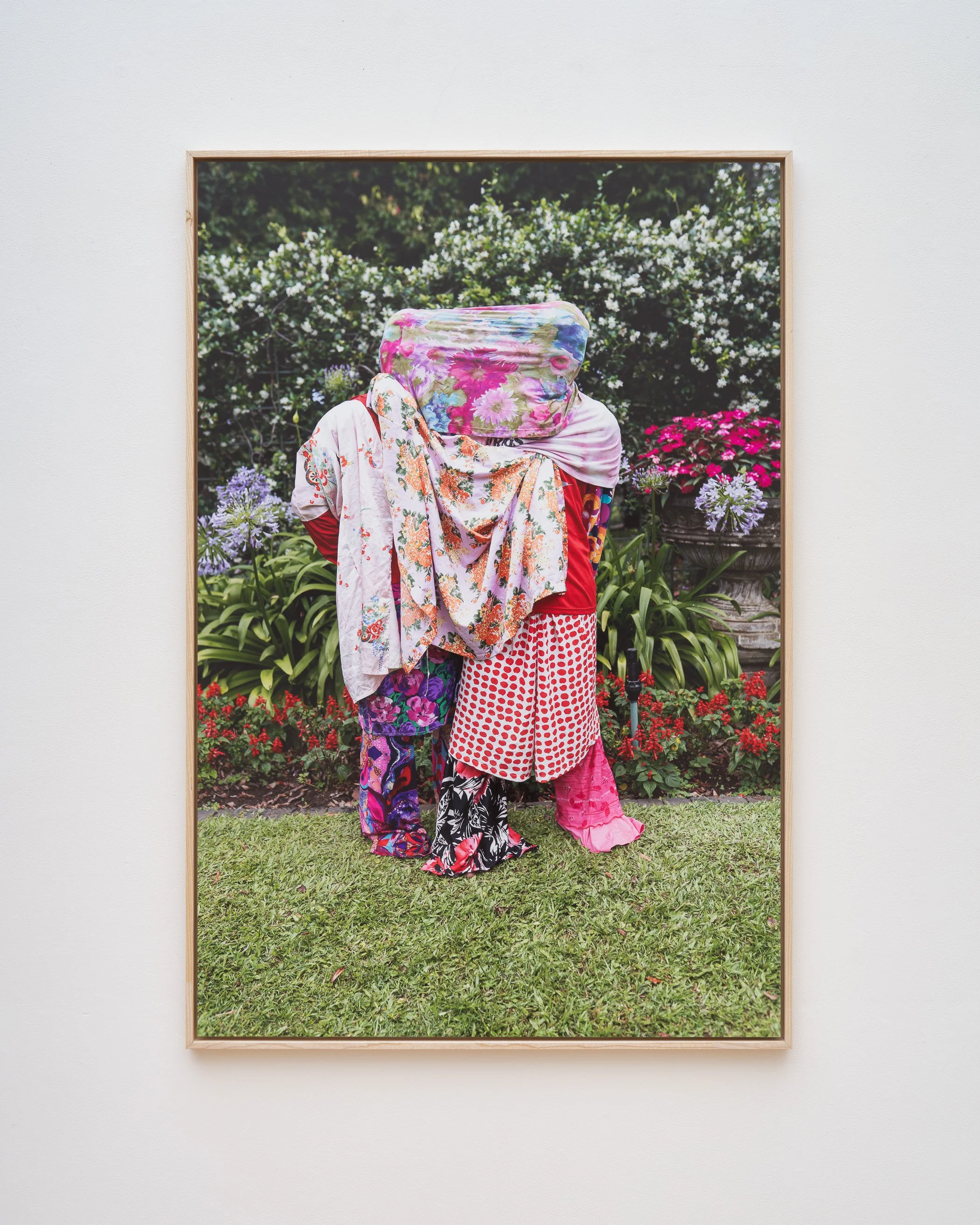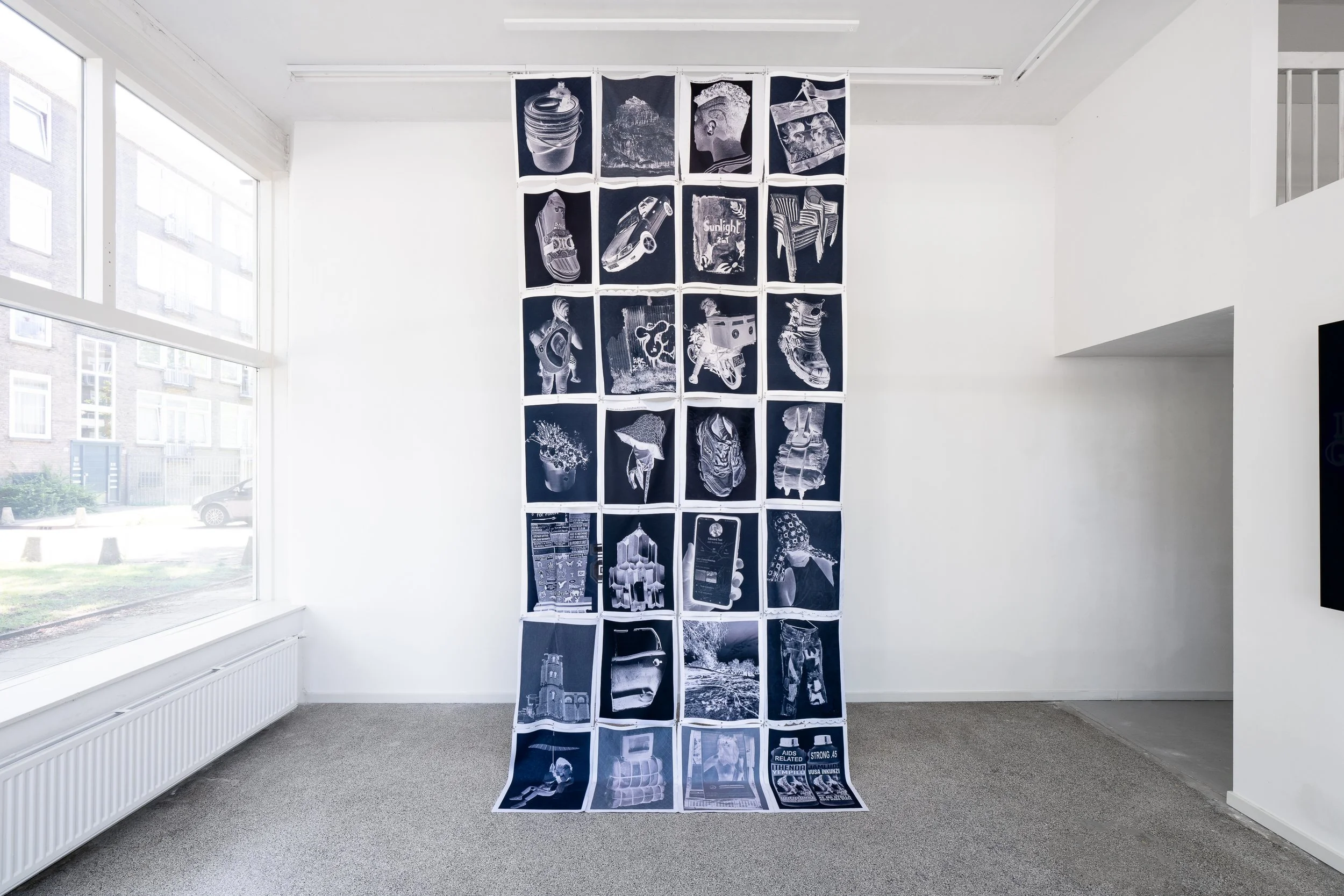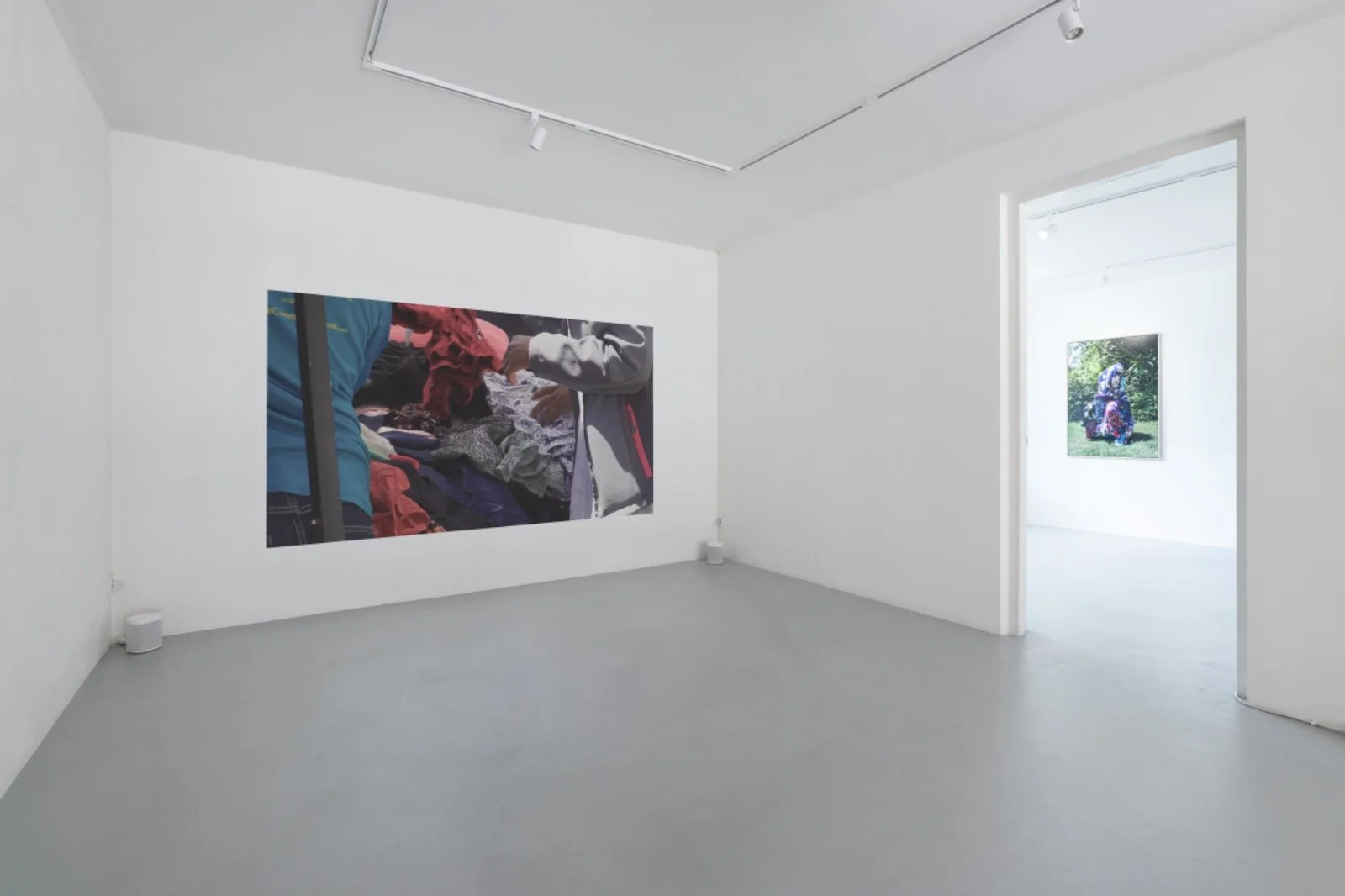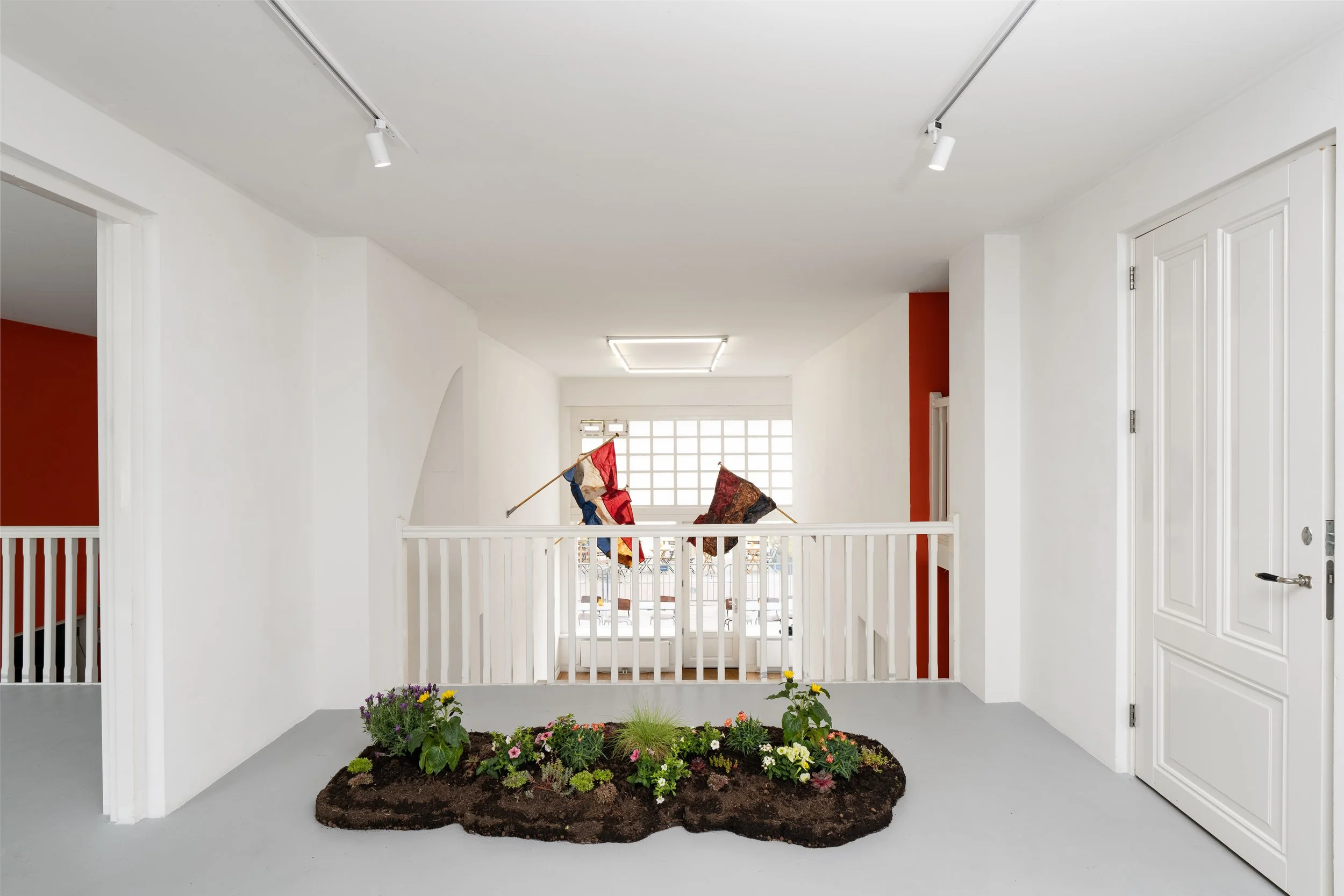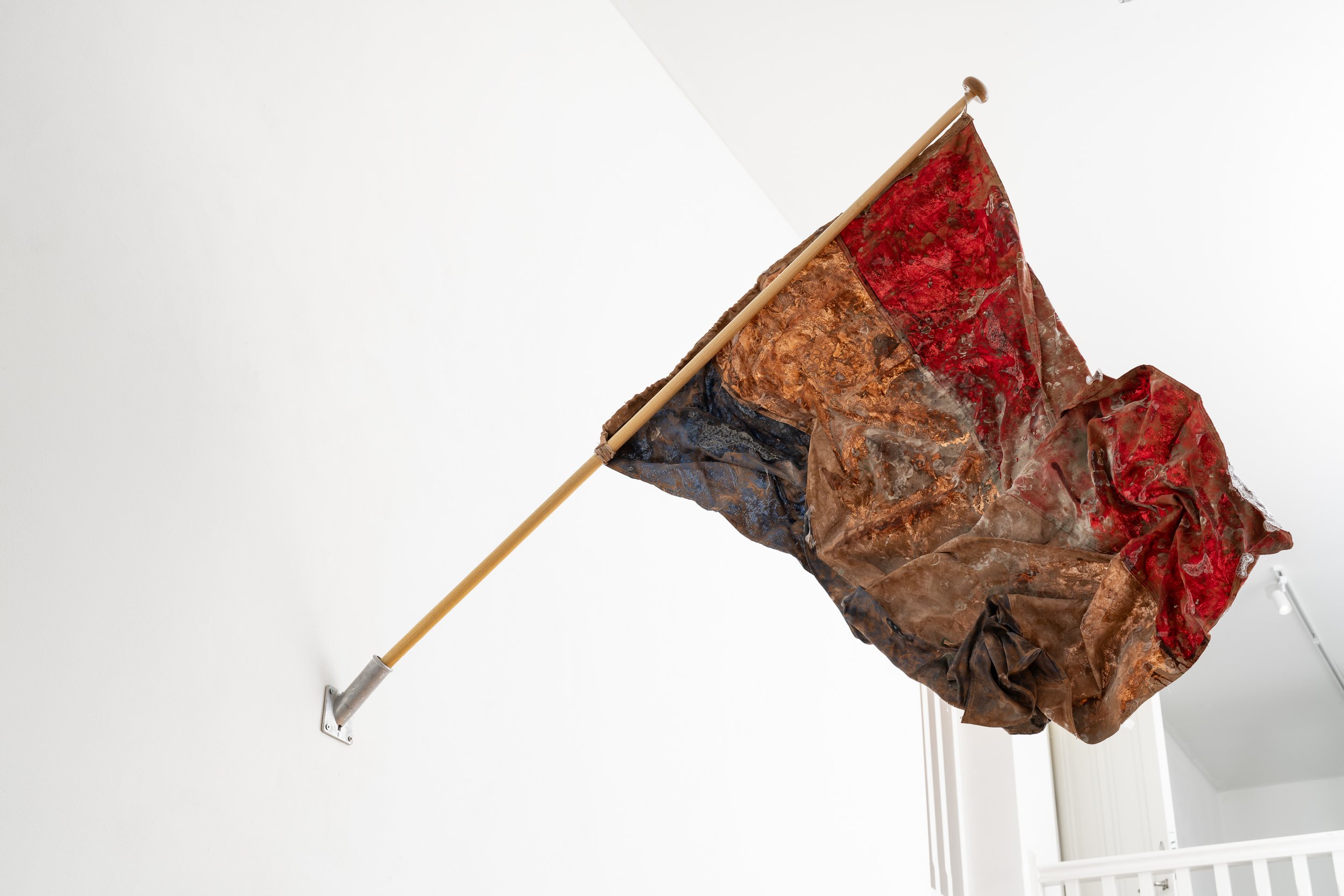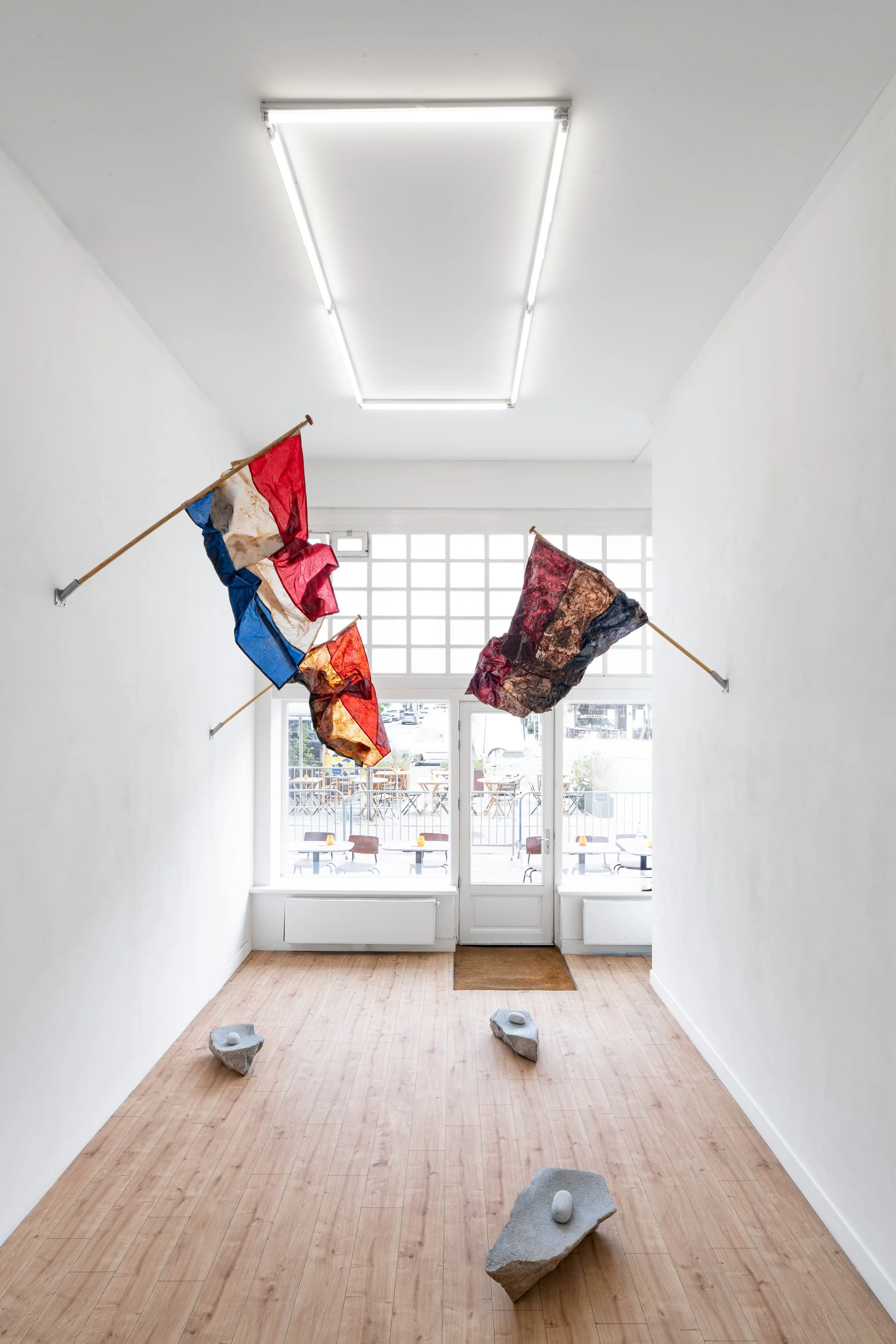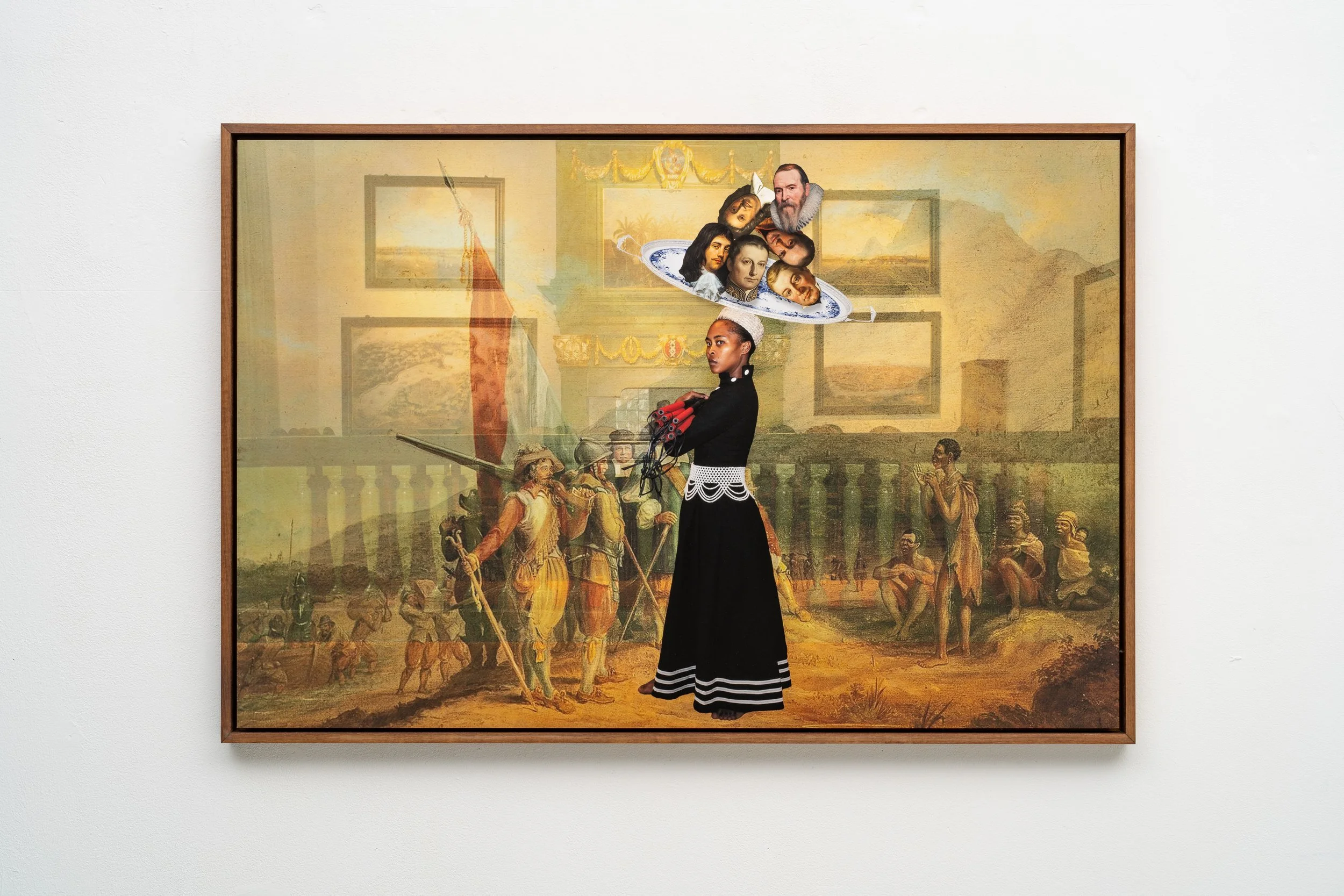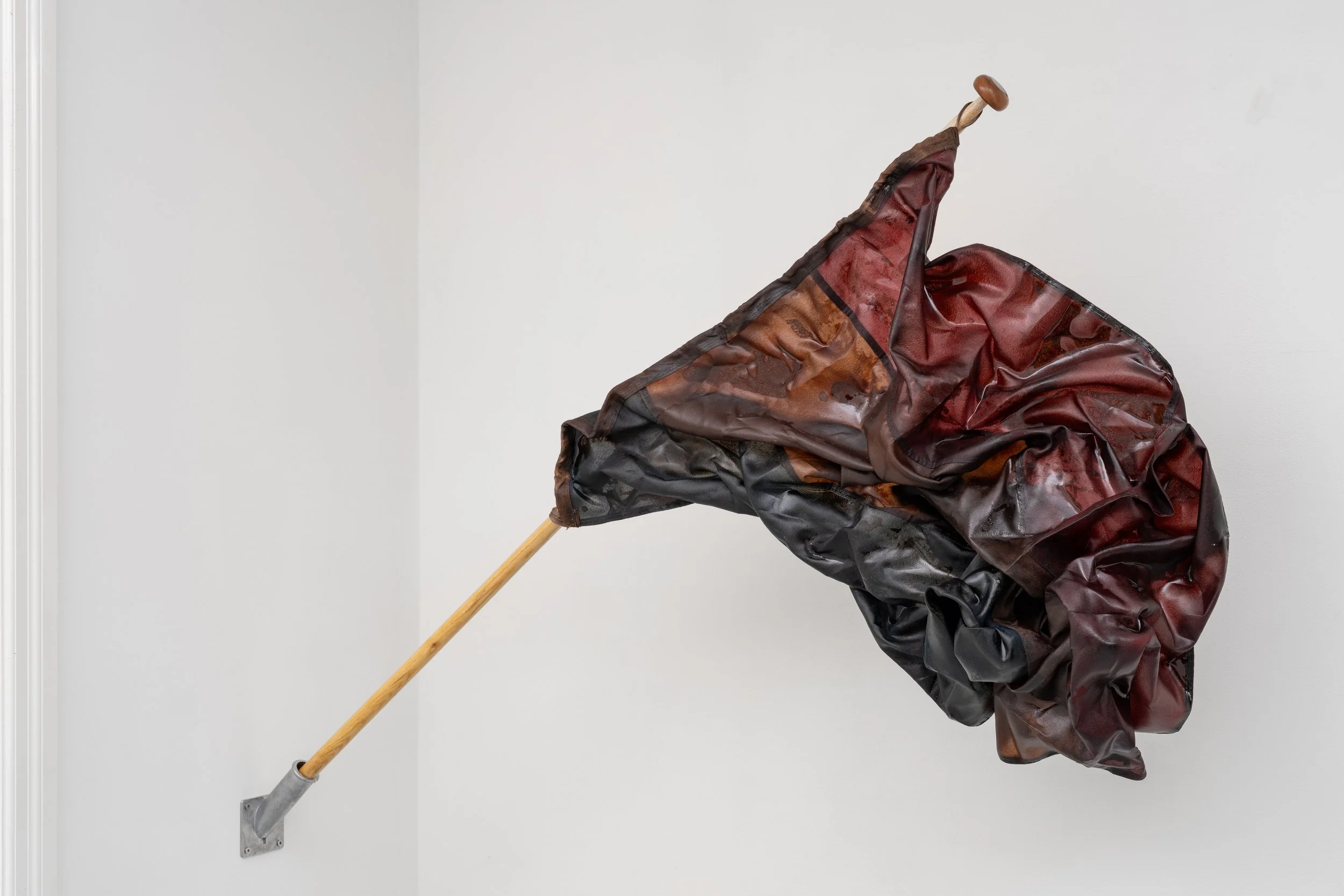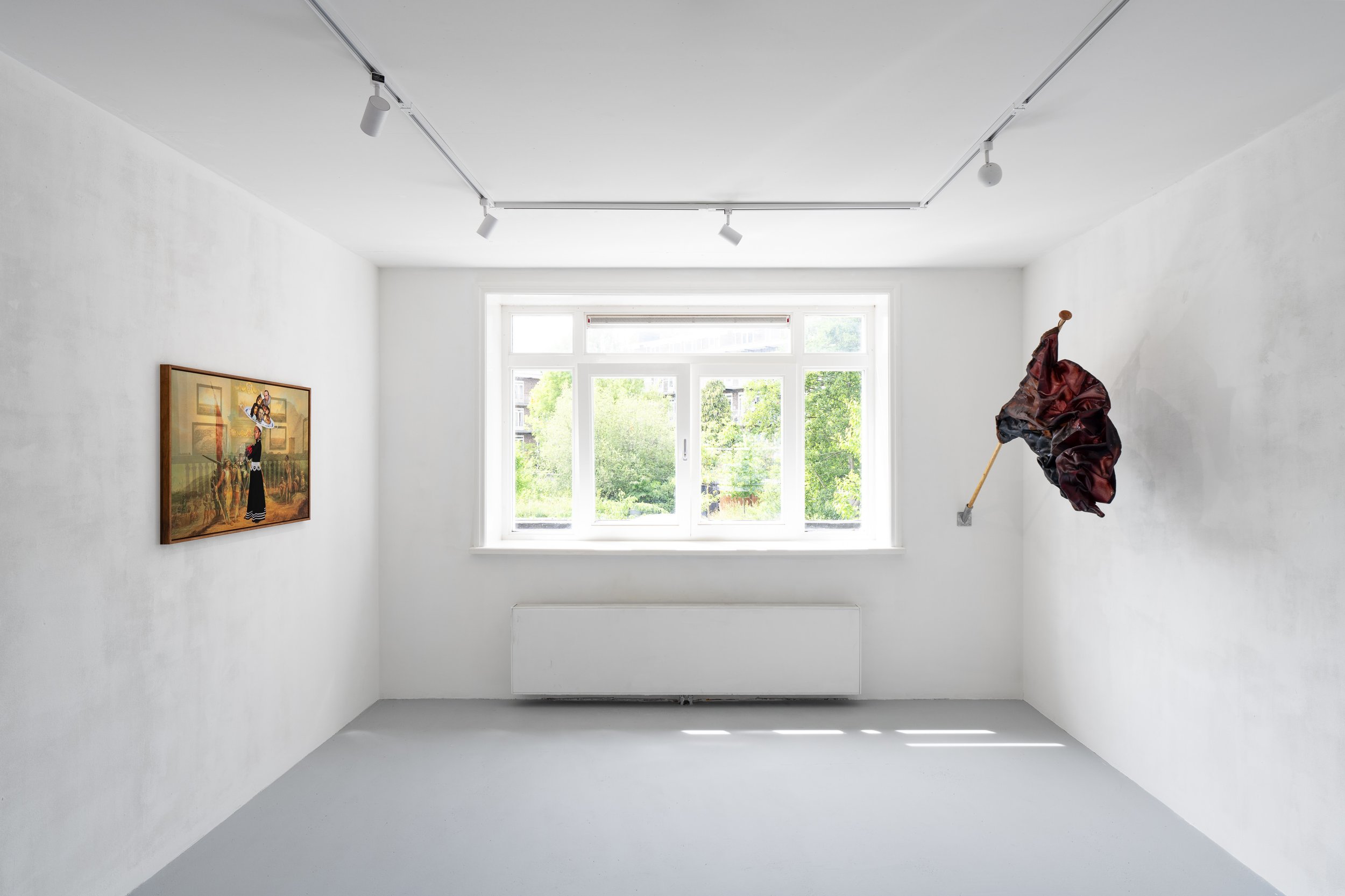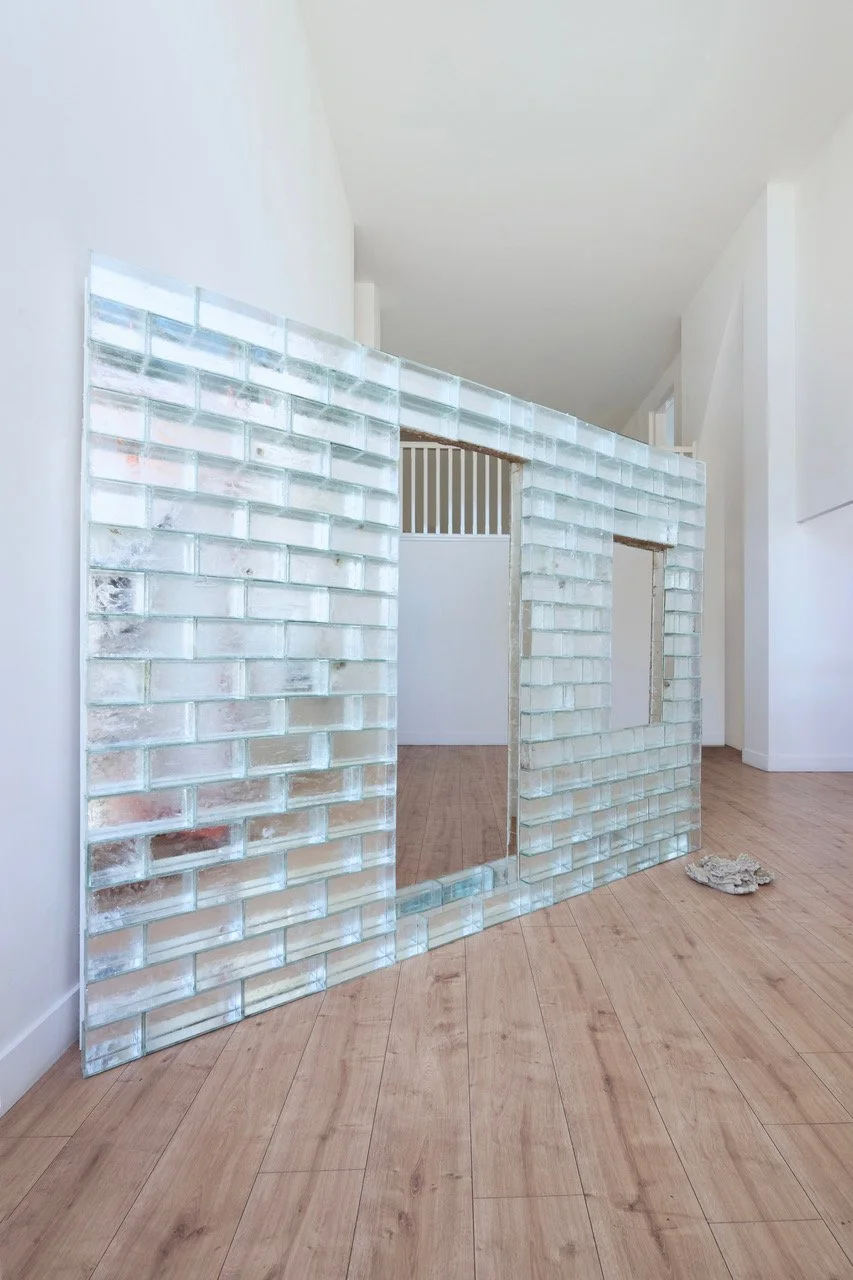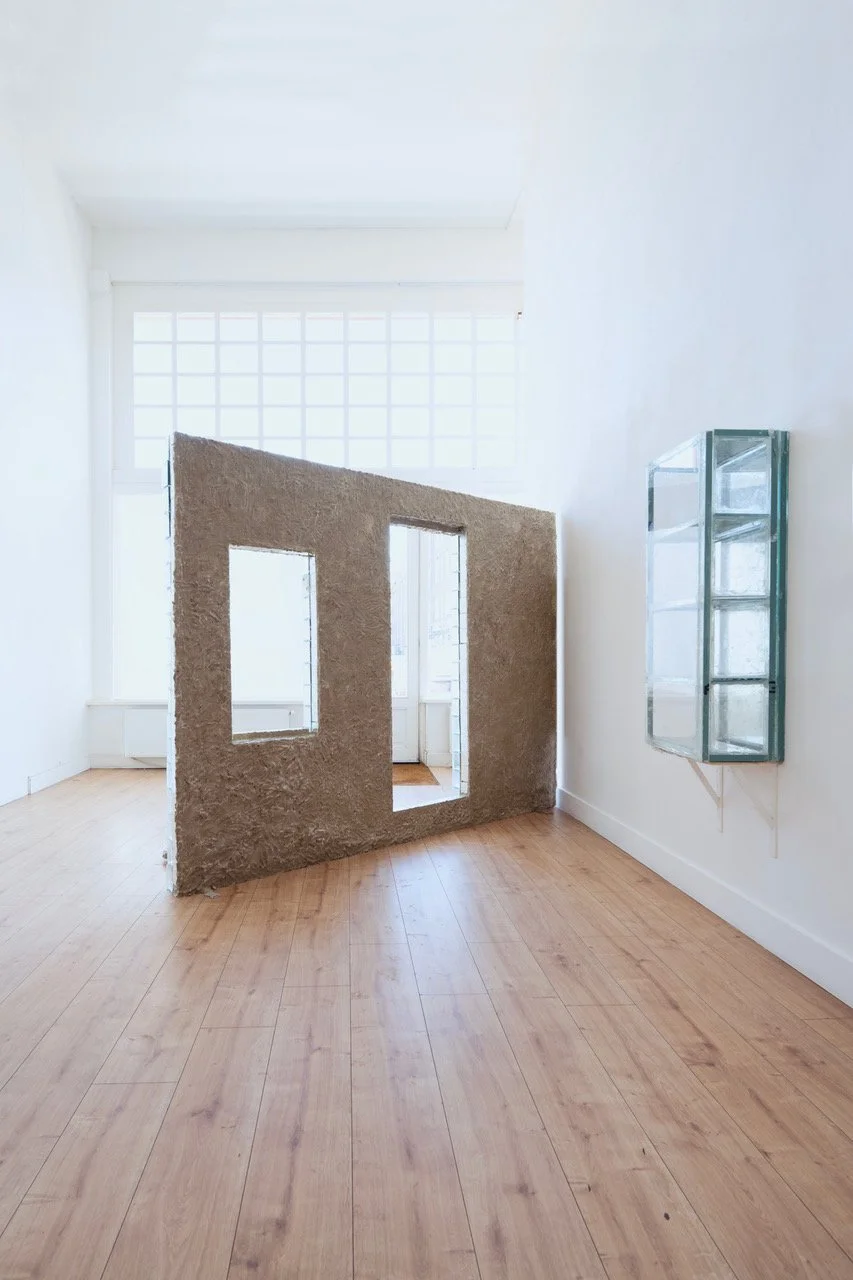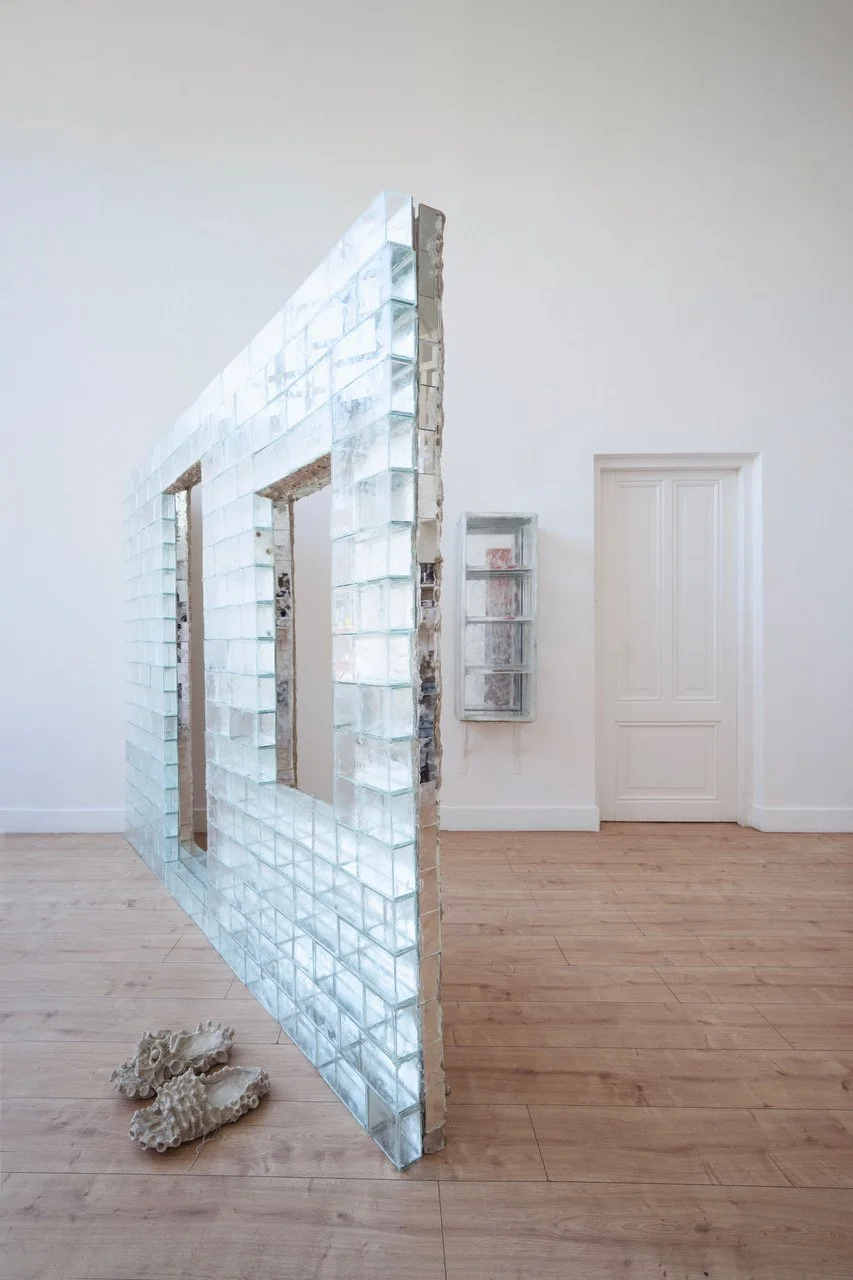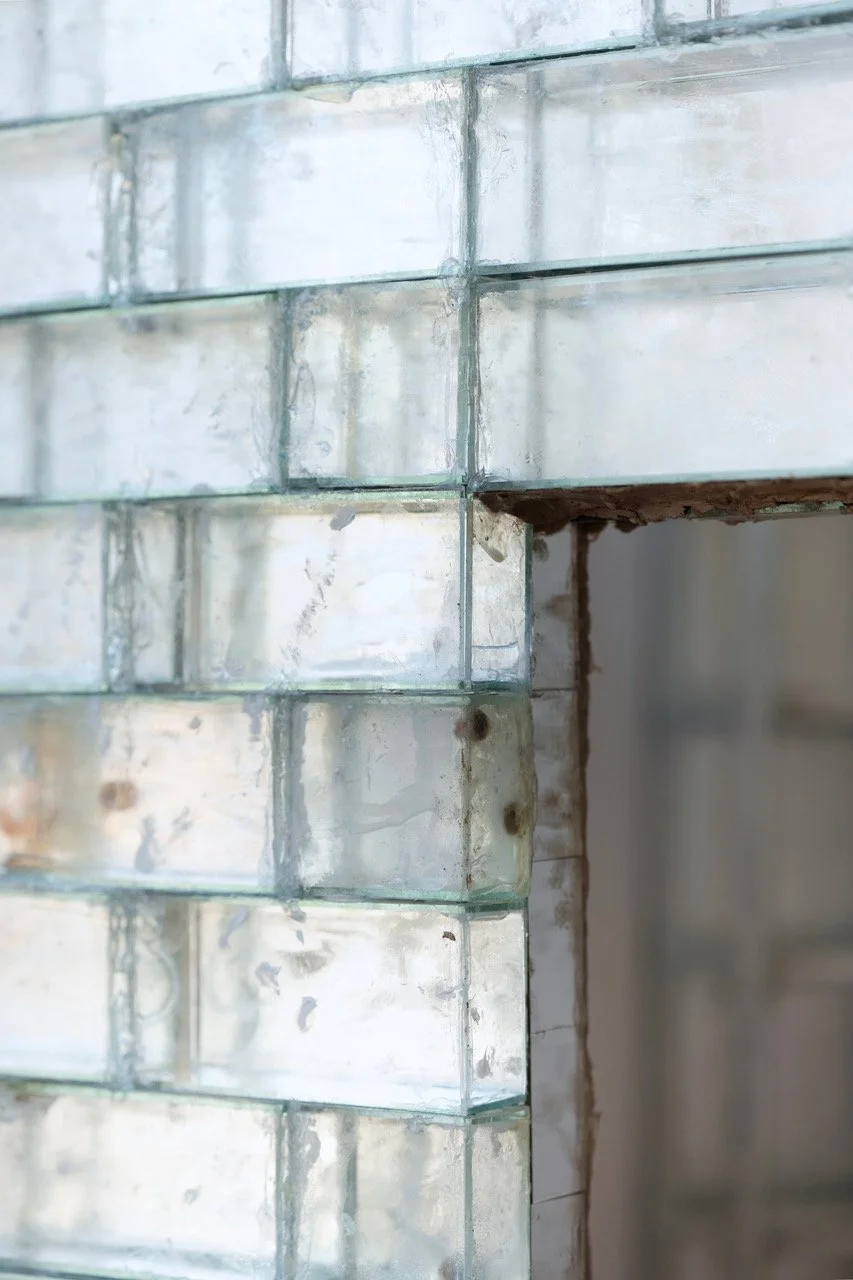Puppet Masters | Museum Jan Cunen, NL
afra eisma, drip drop boobie spider (detail), 2023. Textile, thread, stuffing, and sound. Installed dimensions variable. Photo by Jules Lister.
We are honored to announce that afra eisma will be part of the exhibition Puppet Masters at Museum Jan Cunen, the Netherlands. In this show, boundaries between puppeteer and puppet, control and surrender, and art and reality are blurred. Through their familiarity, puppets confront us with our own questions and imperfections. They hold up a mirror, both in theatre and art. Puppet Masters invites artists from the Netherlands and abroad to address the most diverse subjects through the concept of a puppet.
Fantastic Creatures | Museum Van Bommel Van Dam, NL
Photographed by Minted Media, 2025
From October 4, 2025, to March 22, 2026, Museum Van Bommel Van Dam presents the exhibition Fantastic Creatures. This international group exhibition features mostly recent works by renowned and promising artists who draw inspiration from mythical figures and age-old stories. Through fabulous beings expressed in textiles, drawings, ceramics, paintings, videos, and installations, they reflect on current issues such as identity, culture, and social relations. What makes this exhibition so special is the way it connects the old with the new: myths may be stories from the past, but at the same time they are living traditions that continue to evolve and resonate with new generations.
We are beyond honored that five of our artists will participate in this exhibition: afra eisma, Alejandro Galván, RojoNegro, Buhlebezwe Siwani and María Sosa. Alongside: Jamel Armand, Marianne van der Heijden, Camille Henrot, Susanna Inglada, Hella Jongerius, Wouter Osterholt, Tanja Ritterbex, Nina van de Ven, Theresa Weber en Müge Yilmaz. Curated by James Hannan.
haus of fibre | textielmusuem, NL
We are honoured to announce that afra eisma will be part of the upcoming group exhibition Haus of fibre at TextielMuseum, Tilburg. This exhibition shines light on the role of textiles in the work of artists from the LGBTQIA+ community. The group exhibition takes place in the setting of a house, complete with a living room, kitchen, bedroom, hallway and garden. This layout is inspired by the shared experience of queer people having to create their own home and family in order to live safely outside the framework of the classic cisgender, straight family.
Nocturnals | Curated by Eline Doodeman
online catalogue
08.11 - 20.12. 2025
“Let the right to opacity, whereby diversity will best be preserved and acceptance strengthened, be a lamp watching over our poetics.”
(Édouard Glissant, Treatise on the Whole-World)
No Man’s Art Gallery presents Nocturnals, a show presenting the tangible and intangible whisperings of life that happen in the company of darkness. Both sensitive and elusive, the night's opaqueness is used as a strength rather than an aesthetic alone.
The artworks emerge as protagonists that embody the same bristling perplexities that animate the night itself. They play with cosmic distances, portals to other realms, and create space for a fluid sense of identity. Nocturnals not only highlights the tensions of the night, but celebrates their right to co-exist.
Participating artists:
Mia Chaplin
afra eisma
Benjamin Francis
Alejandro Galván
Alan Hernández
Jamal Nxedlana
Sam Samiee
Marilyn Sonneveld
Between 20 December 2025 and 11 January 2026 the gallery is only open by appointment.
Exhibition overview of Nocturnals, with Polilla (2022) by Alan Hernández and The Loom #1 (2019) by Sam Samiee, No Man’s Art Gallery, Amsterdam, NL, 2025, photo: Jonathan de Waart
Art Antwerp 2025
online catalogue
Art Antwerp
Booth A46
11 - 14 December 2024
afra eisma
RojoNegro
Sam Samiee
Buhlebezwe Siwani
NMAG’s participation at Art Antwerp is supported by Mondriaan Fonds.
Art Antwerp 2025. All images by Ben Van den Berghe - We Document Artmild tooth of milk | DUTCH WAREHOUSE, kochi, hosted by MusEUM of Art & Photography, India
afra eisma, warrior garments, 2023 textile, thread, stuffing, sound displayed at the Tetley, Leeds, UK. Photography by Jules Lister
We are proud to announce that afra eisma will present their solo show mild tooth of milk with the Museum of Art and Photography at the Dutch Warehouse in the port town of Kochi, India. The show will run alongside Kochi-Muziris Biennale 2025–26, with eisma’s vibrant textiles and tapestries creating an entanglement of play, vulnerability and softness.
More information at Museum of Art and Photography.
61st Venice Biennale | Mexican Pavillion
The Ministry of Culture of the Government of Mexico and the National Institute of Fine Arts and Literature (INBAL) announce that the RojoNegro Collective, made up of María Sosa and Noé Martínez, has been commissioned to represent Mexico at the 61st International Art Exhibition at the Venice Biennale, which will take place from May 9 to November 22, 2026.
After a process of analysis and deliberation, the proposal by RojoNegro, titled Actos invisibles para sostener el universo, curated by Jessica Berlanga Taylor, was selected for its conceptual framework and its ability to articulate sensitive, situated, and critical visions. The proposal addresses urgent topics such as ancestral memory, epistemic justice, decolonization, and relational ecology, drawing on indigenous, Afro-descendant, and peasant cosmogonies not as external references, but as living matrices of thought that shape their forms of creation, connection, and imagination.
RojoNegro is an artist duo consisting of María Sosa (1985) and Noé Martínez (1986), whose practice interweaves ancestral memory, the languages of the body, and ritual technologies from a decolonial perspective. Through installation, performance, sound, and the use of organic materials, their work summons situated forms of knowledge that question processes of colonization and their persistent effects on bodies, territories, and contemporary worldviews.
The project will dialogue with In Minor Keys (Modo Menor), the curatorial proposal of the 61st edition, developed from the vision of the late curator Koyo Kouoh, which conceives the exhibition as a collective score created with artists whose work merge organically with society.
RojoNegro, Retrato de Sombra I, 2024. Oil and acrylic on paper, 208 x 110 cm. Image courtesy of the artists.
María Sosa graduated from the Universidad Michoacán de San Nicolas de Hidalgo. Sosa’s practice stems from her research about our shared colonial past and how it constitutes contemporary social dynamics as an epistemicide of prehispanic worlds, racism, sexism, and the invisibility of multiple nonwesterner’s ways of life in the American continent. Sosa’s work is nourished by her research of prehispanic art, anthropology, the methodology of Ecología de Saberes and the exploration of production techniques of ritual prehispanic and contemporary objects.
Noé Martínez is a visual artist and filmmaker who graduated from Escuela Nacional de Pintura, Escultura y Grabado (“La Esmeralda”) in Mexico City. His work functions as a case study that emerges from personal history, making use of ethnographic methodologies and research of the various histories of indigenous communities of the American continent.
RojoNegro’s recent solo exhibitions include: Debut Solo Exhibition, No Man’s Art Gallery, Amsterdam (NL), upcoming; Volví a ser vasija, volví a ser animal a ser planta, volví a ser tiempo, Museo de Arte de Zapopan, Zapopan (MX), 2024; Tepalcates de sueños, commissioned by the Swiss Institute of New York in Mexico City (MX), 2022; and El encuentro de los tepalcates, an offsite project with a performance and presentation video commissioned by the Swiss Institute of New York (USA), 2021.
Their group exhibitions and projects include: Commission for Stuart Collection of UCSD University of San Diego (USA), upcoming; Fantastic Creatures, Museum Van Bommel Van Dam, Venlo (NL), upcoming; Transmisión Ancestral, Plataforma, Guadalajara, Jalisco (MX), 2024; Cordillera, Galería Extra, Guatemala City (GU), 2024; Las estrellas me iluminan al revés, No Man’s Art Gallery, Amsterdam (NL), 2022; and their participation in the Venice International Performance Art Week, Palazzo Mora, Venice (IT), 2016.
Shortlist Prix de Rome Visual Arts 2025 | Stedelijk Museum Amsterdam
We are proud to share that Buhlebezwe Siwani has been nominated for the Prix de Rome Visual Arts 2025. Alongside three other nominees, she will receive a production budget to create new work over the coming months. The resulting artworks will be presented at the Stedelijk Museum Amsterdam starting Saturday, 29 November 2025. A publication accompanying the exhibition will also be released.
More information here.
WHAT’S YOUR TREASURE? | MASIR CURATORIAL
We are proud to share that Sam Samiee will be taking part in group exhibition What’s Your Treasure?, brought together by Masir Curatorial in Shiraz, Iran.
Held in Kazerouni House, an architectural heritage site in the heart of old Shiraz, What’s Your Treasure? explores the meaning of ‘treasure’; the house is a treasure of the past and the showcased works each hold something about life. Throughout the week, the curators will engage in conversations with selected artists at Roniyas Hotel.
Please find further information here.
Minor Attractions 2025
Online Catalogue
Minor Attractions 2025
October 14 - 18, 2025
THE MANDRAKE, London
We are honoured to announce our debut participation at Minor Attractions 2025 with a presentation by Benjamin Francis.
Minor Attractions is an art fair hosted at The Mandrake Hotel inviting global commercial galleries and not-for-profit art spaces. The fair is designed as a space where art and nightlife meet, allowing the swells of international collectors in the city to mingle with the art workers and artists that make the art world tick.
Remember our united beginning | Monument trans-Atlantisch slavernijverleden in Den Haag, NL
The visual arts institution Stroom Den Haag has nominated three artists to the municipality to submit a draft design for the monument, among them is the artist we represent, Buhlebezwe Siwani. With her draft design now completed, a jury will select the artist who will be commissioned to finalize and realize the project. For this project Siwani reflected on how to represent both residents and their heritage through a meaningful, symbolic artwork. They aimed to create a powerful and unifying symbol that acknowledges the past with empathy, without dwelling on pain.
More information here.
Artist in Residence | Casa Wabi, Oaxaca, MX
Exhibition overview of I Hit You With a Flower — sugar-coated art with a punch at MABA, France. Photo by Aurélien Mole
We are honored to announce that Alan Hernández is selected as resident at Casa Wabi, MX. The program exists to promote social development through the arts by facilitating mutually beneficial cultural exchanges between artists in any discipline from all over the world and the people, ecology, and ethos of coastal Oaxaca. We host three to six artists at a time in five or six week sessions on the beach north of Puerto Escondido. Every one of our residents is required to find a meaningful way to connect in one of the communities around Casa Wabi through a reciprocal community project. Social connections and cultural cross-pollination are the focus, rather than the production of a specific body of work. We expect our residents to plant seeds of inspiration here in Oaxaca and to spread what they take away.
Book Launch & Opening: “splashdown tender” and soft conversations | Page Not Found
afra eisma, splashdown tender, 2025. The first major monograph by the aritst, co-published by Page Not Found
Page Not Found is pleased to announce the publication of splashdown tender, the first major monograph by afra eisma, co-published by Page Not Found. To celebrate this landmark book, eisma has conceived soft conversations, a solo exhibition opening on September 24th, 2025. Through a deconstructed studio setting, eisma invites visitors to settle into a colorful fusion of textile works. The exhibition runs from September 25th through November 2nd, 2025.
spashdown tender includes contributions by Sara Ahmed, Delphine Bedel, Adrian Bridget, Ama Josephine Budge Johnstone, Diana Campbell, Jordan Karney Chaim, Clem Edwards, Raphael Fonseca, Jori(k) A. Galama, Chihiro Geuzebroek, Daisy Lafarge, adrienne maree brown, Martina Milla, Jo-Lene Ong, Jay Tan, Meenakshi Thirukode, Danielle Vorthuys, and Romy Day Winkel. Edited by Dagmar Bosma.
The book is co-published by Page Not Found and will be released on the opening night. This project is made possible with support from the Municipality of The Hague.
More information at Page Not Found
Preorder the book here
I Will See You On The Other Side | De Kerk
From 19 September until 12 October Buhlebezwe Siwani presents work in De Kerk as part of the exhibition ‘I Will See You On The Other Side’, curated by Marcos Kueh. Kueh is known for his colorful and detailed textile art. In his work, he explores how his motherland is perceived and translates contemporary legends onto textiles. The artist was invited by Unfair to create new work, and was asked to curate a group exhibition around this work.
From this came “I Will See You On The Other Side”, an exhibition that makes you think about forces beyond our material existence and that explores alternative visions of the afterlife: from a fascination with the end of time to spiritual transformation.
Participating artists:
Marcos Kueh
Erwin Olaf †
Buhlebezwe Siwani
Jennifer Tee
Samboleap Tol
Martin Toloku
Bouke de Vries
Ellen Yiu
Tokyo Gendai 2025
Online Catalogue
Tokyo Gendai 2025
September 12 - 14, 2025
PACIFICO Yokohama
We are honoured to announce our debut participation at Tokyo Gendai 2025 with a solo presentation by afra eisma in Tokyo, Japan.
No Man’s Art Gallery’s participation is kindly supported by the Mondrian Fund.
Press:
- Tokyo Gendai confirms Japan’s rising market strength, by Elia Carollo, Observer, Sept. 2025
Photos by Kohei Omachi
Los fragmentos que curan | RojoNegro
online catalogue
06.09.2025 - 26.10. 2025
Opening on Saturday, September 6th, from 5 - 8PM
Official Afterparty of the Gallery Opening Season: 8PM till late
Location: NMAG, Bos en Lommerweg 88-90
No Man’s Art Gallery is honoured to inaugurate the cultural season with Los fragmentos que curan, the debut solo exhibition in the Netherlands by RojoNegro, the artist duo of María Sosa (b. 1985, MX) and Noé Martínez (b. 1986, MX). In a new body of work, they approach the body as a site of ritual and spiritual dialogue, opening a chapter where ancestral knowledge and contemporary realities meet, transform and renew one another.
The exhibition centers on the three energetic points of the body described in Nahuatl cosmology: the heart, the liver and the head, each materialised in installations with fragments that interweave materials such as papel amate (handmade bark paper), ixtle thread, tobacco, crystal eyes and decorated cacao seeds.
One such work is Altepetl (2025), Nahuatl for “mountain” or “hill” (atl = “water” + tepetl = mountain) - a metaphor for place or state. Here, different fragments appear as birds, symbols of the heart in Mesoamerican culture. They are believed to take flight at the moment of death. Like a net, the work binds them together into an embodied territory, becoming a mountain that shelters a community.
In Reconstrucción del tonal (2025), RojoNegro turns to the tonal, the energetic essence of the head, associated with the sun and destiny. The work reflects on the foundations of their practice, suggesting a world that contains and coexists with many others. It is adorned with handwritten texts from the Declarations of the Selva Lacandona (the Zapatista Manifesto), a poetic call for Indigenous rights and resistance, alongside excerpts from the Mexican Constitution:
“Many words walk in the world. Many worlds are made. In the world of the powerful there is no space for anyone but themselves. In the world we want everyone to fit in. In the world we want many worlds to fit.” (From the Declarations of the Selva Lacandona)
Across the gallery, smaller canvases confront contemporary violence against bodies, race, and ecologies. Texts such as ‘Hay un México lleno de ojos que buscan’ (‘There is a Mexico full of eyes that search’), reference the countless disappearing throughout the country. Through these works, the artists ask how collective healing and the restoration of balance might be possible.
Alongside these, larger oil paintings such as Autorretrato de sombra II (2025) draw on pre-Hispanic codices and archaeological remains. Centered on the shadow, a liminal space between life and death, matter and spirit - the painting merges RojoNegro’s bodies into a collective self-portrait where archaeological figures resurface. Around them appear corn seeds for divination, the fallen warrior alongside a pregnant woman as a parallel form of struggle and dignity, the calves and legs as vital sites of strength in Mesoamerican thought and the jarilla amarilla, a plant used for energetic cleansing.
These figures connect to the video work Habitar lo oculto (2023), where RojoNegro re-stage the postures of archaeological figures through the body, releasing them from vitrines and returning them to life.“Our figure as artists, as a duo is really a vehicle for an objective: that these voices, silenced for 500 years, may live, may exist,” they write.
The practice of RojoNegro emerges from dialogue, kinship and the sharing of dreams. “Every day we wake up talking about our dreams,” they note. Dreams become repositories of knowledge, linking individual experience to collective memory and offering glimpses of other ways of being together.
With Los fragmentos que curan, RojoNegro opens a portal into narratives that remain alive in the present. At once political and poetic, the exhibition confronts the violence of colonisation and capitalism while insisting on the possibility of repair. “Contemporary art and practice is a platform for dialogue between the ancestral and the current and as a platform of care, because what is at stake is memory and life itself.” Each work is a fragment, yet together they assemble a world where balance and renewal become possible.
Installation view of Los fragmentos que curan, solo exhibition by RojoNegro (Noé Martínez and María Sosa). No Man's Art Gallery, Amsterdam, NL, 2025. Image by Jonathan de Waart
Installation view of Los fragmentos que curan, solo exhibition by RojoNegro (Noé Martínez and María Sosa). No Man's Art Gallery, Amsterdam, NL, 2025. Image by Jonathan de Waart
Installation view of Los fragmentos que curan, solo exhibition by RojoNegro (Noé Martínez and María Sosa). No Man's Art Gallery, Amsterdam, NL, 2025. Image by Jonathan de Waart
Installation view of Los fragmentos que curan, solo exhibition by RojoNegro (Noé Martínez and María Sosa). No Man's Art Gallery, Amsterdam, NL, 2025. Image by Jonathan de Waart
Autorretrato de sombra II (Detail), 2025, Oil and acrylic on canvas, 208 x 110 cm. Image by Jonathan de Waart
María Sosa graduated from the Universidad Michoacán de San Nicolas de Hidalgo. Sosa’s practice stems from her research about our shared colonial past and how it constitutes contemporary social dynamics as an epistemicide of prehispanic worlds, racism, sexism, and the invisibility of multiple nonwesterner’s ways of life in the American continent. Sosa’s work is nourished by her research of prehispanic art, anthropology, the methodology of Ecología de Saberes and the exploration of production techniques of ritual prehispanic and contemporary objects.
Noé Martínez is a visual artist and filmmaker who graduated from Escuela Nacional de Pintura, Escultura y Grabado (“La Esmeralda”) in Mexico City. His work functions as a case study that emerges from personal history, making use of ethnographic methodologies and research of the various histories of indigenous communities of the American continent.
RojoNegro’s recent solo exhibitions include: Volví a ser vasija, volví a ser animal a ser planta, volví a ser tiempo, Museo de Arte de Zapopan, Zapopan (MX), 2024; Tepalcates de sueños, commissioned by the Swiss Institute of New York in Mexico City (MX), 2022; and El encuentro de los tepalcates, an offsite project with a performance and presentation video commissioned by the Swiss Institute of New York (USA), 2021.
Their group exhibitions and projects include: Commission for Stuart Collection of UCSD University of San Diego (USA), upcoming; Fantastic Creatures, Museum Van Bommel Van Dam, Venlo (NL), upcoming; Transmisión Ancestral, Plataforma, Guadalajara, Jalisco (MX), 2024; Cordillera, Galería Extra, Guatemala City (GU), 2024; Las estrellas me iluminan al revés, No Man’s Art Gallery, Amsterdam (NL), 2022; and their participation in the Venice International Performance Art Week, Palazzo Mora, Venice (IT), 2016.
There is no going back | Shivangi Kalra
ONLINE CATALOGUE
06.09.2025 - 26.10.2025
Opening on Saturday, September 6th, from 5 - 8PM
Official Afterparty of the Gallery Opening Season: 8PM till late
Location: NMAG KIOSK, Willem de Zwijgerlaan 327
No Man’s Art Gallery is honoured to present There is no going back, the first solo exhibition of Delhi-born artist Shivangi Kalra with the gallery, hosted at its second location, KIOSK. On view from September 6th to October 26th, the show forms part of KIOSK’s new program, dedicated to showcasing emerging talent and collaborative projects.
Kalra’s intricate painting revisits scenes of social gatherings from her childhood in Delhi, set within the opulent interiors she remembers. These works capture both the festivity and the social constructions embedded in these moments, revealing beauty, nostalgia and quiet tensions. Inviting prolonged contemplation, her compositions seem to hold time still, welcoming audiences into these extended memories now taking physical form in the gallery space.
Photos by Jonathan de Waart
Shivangi Kalra (b. 1998, Delhi, IN) is a visual artist currently based in Amsterdam. She did her Bachelors in painting from College of Art, Delhi (2021) and then moved to the Netherlands to pursue her Masters (painting) at Frank Mohr Institute, 2022-24, thanks to receiving Elizabeth Greenshields Grant and Holland scholarship in 2022, 2023.
After graduating cum laude, she won the Dutch Royal Painting Prize 2024, exhibiting her work in the Dam Palace of Amsterdam. She later won a prize at Galleria Doris Ghetta, resulting in a solo exhibition in Italy, followed by a solo show at Method India in February 2025. She was the first artist in residence at Zawyaty HQ, Marrakech, in 2025. She is presently working towards projects in Paris, Berlin, and the Netherlands later this year.
35 years of minds and matter | from the archive of Kunstinstituut Melly
A Garden of Clouds, 2022, Kunstinstituut Melly, Rotterdam. Photographer: Kristien Daem.
In 2025, Kunstinstituut Melly celebrates its 35 year anniversary and to honour that milestone 35 Years of Minds and Matter celebrates the archive. This exhibition will shine light on its starting point artists who have exhibited at Kunstinstituut Melly, and we are proud to announce that Sam Samiee is amongst those artists. A Garden of Clouds is inspired by a close engagement with the Rotterdam Stadsarchief, and explores the contsruction and evolution of Rotterdam’s Cool district.
Please find further information here.
Data Tapestries | Jamal Nxedlana
Online Catalogue
19.07.2025 - 24.08.2025
Opening on Saturday, July 19th, from 5 - 8 PM
Location: NMAG, Bos en Lommerweg 88-90
NMAG KIOSK, Willem de Zwijgerlaan 327
thrifting as method
by Mpho Matsipa
Johannesburg, 2025
Jamal Nxedlana is interested in used clothing in Johannesburg. This pre-occupation has shifted and developed as his practice has expanded including his studies in Fashion Design and the role of used clothing as a vehicle of self-expression, or an article of exchange and when a cipher for narrative expression for photo shoots and other creative purposes. Johannesburg central business district (CBD) was once a booming mining town and the fulcrum of white settler colonial modernity, that now inhabits a dichotomous discursive zone between either being a bustling, elusive African metropolis[1] or a ‘ruin’ of racial capitalism, spatial violence and racialized abandonment[2]. Nxedlana, eschews these binary oppositions. He deploys his background in fashion design to explore how fashion might respond to colonial and postcolonial legacies in urban South Africa. This interest has manifested in his exploration of used clothing markets in the city through photography, moving image and textile art. The city offers a mis-end-scene for aliveness through the tropes of recycling, up cycling and their relationship to the reduction of waste, conservation of resources and savings on dumping sites.
While the work obliquely registers growing concerns over the impact of disposal of post-consumer textiles waste in Africa, and the dual environmental challenges posed by fast fashion and its related ecological toxicity, Nxedlana’s practice of thrifting re figures Johannesburg as a site of diverse cultural identities that intersect with practices, technologies and logistics that invite geopolitical inquiry with practices that combines sorting, selection, discernment and bargain hunting and decomposition with a focus on sustainability and resourcefulness and re-invention. This creative preoccupation with a tumultuous city with a long history of extractivism, offers rich grounds for speculating about how discarded personal artefacts - ‘transitory kinship structures’[3] - become vehicles that enable dreaming of a future within and against the structural failings that mark our present.
Nxedlana’s relentless exploration of thrifting as a mapping technique: sporadically visiting, geo-locating, photographing, filming and pinning locations of used clothing stores and markets that intersect with Google Earth screenshots from various angles, remembers the central business district of Johannesburg as a constellation of clothing ecosystems, narratives, bodies, and temporalities against the regimentation of dedicated inventory delivery and stocking days. In his collages, the city is reconstituted as a rhizomatic field of encounters, and repetition without serialization. An unexpected combination of textures, a disturbing stain, a tear, a loose thread or distressed fabric not only bespeaks a previous life, long since discarded and forgotten, but the base for material transformation. His process of tagging, layering and enfolding mirrors the spacetime of this part of the inner city, and how rhythms of thrifting can register improvisational, speculative and provisional quality of some of Johannesburg’s densest urban spaces.
Nxedlana’s city is far from topological. He works photographs or found visual imagery, to make collages as a way of testing the relationship between different places or different objects or just putting ideas onto a surface. Working between images taken from Google Earth, together with photographs that he has taken of the places that are specifically related to the selling of used clothing and either sellers, shoppers, or creative entrepreneurs emerge as the outcome of his research on yolo (object detection algorithm) but also on data visualisation practices, techniques in scientific research and art practice. It's a reimagining of the city as datascape, and that used clothing is encoded with data in a wider sense. The collage as a poetic tactic to register data collection in a rippling field of micro-gestures generates a speculative and poetic cartography of the city’s thrifting eco-systems. It draws you into an intimate relationship, with geopolitical and cultural questions as an act of what Tina Campt (2019) terms, ‘critical relationality’. In another series Made In Joburg he unpicks the garment labels, mining them for hidden narratives relating to the practice of used clothing: how it's shipped and ends up in South Africa. He states:
“(I’m interested in) hidden narratives or maybe not hidden narratives, but not just the narratives that are embedded in the clothing itself, so perhaps where it was made, for which company was it made, where was it sold? So, the actual material data, embedded in used clothes or factual data, but then also speculative data was something I was interested in. So, kind of thinking about the people who may have owned these clothes, the activities they would have done, the journey that the clothing has taken etc. And then as I was kind of, I guess mapping, and this is kind of like my mood board for the project and where I've put works in progress or kind of like sketches.”
Music, fashion, and experimentation are defining features of many African cities—where thrifting plays a key role in youth expression and refusal of hegemonic discourses that foreclose other possible narratives, imaginaries, practices and condition[4]. This fragmentation of micro-gestures in an over- determined, yet indeterminate space of the body, and the city, enacts both a refusal of a single point of view and an affirmation of multiplicity and undecidability of African urban sub-culture. Nxedlana’s scalar shifts and recalibrations are themselves quiet acts of refusal, that simultaneously assert the possibility of world-building in the face of negations, that renders us and our environment unintelligible and disposable.[5] However, his study of stains also offer a re mapping of geopolitical intimacies, a temporal suspension of spatial hierarchies that opens up questions about the foundations of everything, from the machinations of late state capitalism, to the way bodies, and identities, might mingle, touch each other, and leave traces that could lead to material and affective transformations – albeit in radically asymmetrical ways[6].
Nxedlana’s thrifting-as-method serves as a capacious and generative re-imagining of everyday practices that fundamentally scramble stable identities as well as what it means to refuse the terms given to us. In their most utopian light these textile time capsules might be vessels for world-building and coded information exchange[7]. Although they are coeval with uni-directional toxic infrastructures of global trade and disposal, they nevertheless give rise to experimentation and sub-cultures in music and fashion that are the hallmark of dynamic cities in Africa, and the ambivalence and violence of geopolitical intimacies.[8] In this body of work, Nxedlana offers a momentary reprieve: a tactile, sensory engagement with these textiles in a universe of reciprocal exchanges that are familiar, playful, intimate and strange - perhaps a clearing for meaning-making through a sensorial and philosophical response to complex global systems.
References:
[1] Nuttall, Sarah, and Achille Mbembe, eds. Johannesburg: the elusive metropolis. Duke University Press, 2020.
[2] Simone, AbdouMaliq. "People as infrastructure: Intersecting fragments in Johannesburg." Public culture 16.3 (2004): 407-429.
[3] Brown, DeForrest. Assembling a Black Counterculture. New York: Primary Information, 2022. And Wark, McKenzie. Raving. Duke University Press, 2023.
[4] Zililo, Marion, “Interview with thulile Gamedze” in La belle Revue (2018) https://labellerevue.org/en/global terroir/le- cap/entretien-avec-thulile-gamedze
[5] Campt, Tina Marie. "Black visuality and the practice of refusal." Women & Performance: a journal of feminist theory 29.1 (2019): 79-87.
[6] Stoler, Ann Laura, ed. Haunted by empire: Geographies of intimacy in North American history. Duke University Press, 2006. And Pain, R., & Staeheli, L. (2014). Introduction: Intimacy-geopolitics and violence on JSTOR. Area, 344. https://doi.org/24811736
[7] Malatsie, Kabelo, and Lantian Xie, eds. Matter Mattering Matters: A Scienticity Reader. Mousse Publishing, 2025.
[8] Desmond, Vincent, Photos: A Look Inside Nigeria's Alté Subculture, OkayAfrica, https://www.okayafrica.com/nigeria-alte- subculture-inside-photos-look/ also see Jade, Diana, 6 reasons thrift clothing is popular among younger Nairobians (2025) https://www.pulselive.co.ke/articles/lifestyle/fashion/reasons-thrift-clothing-is-popular-among-kenyan- youths-2025061914011052850
Installation views of Data Tapestries, solo exhibition by Jamal Nxedlana, No Man’s Art Gallery, Amsterdam, 2025. All images by Jonathan de Waart
Jamal Nxedlana (b. 1985, SA) is an artist and cultural worker. His practice begins with fashion and subculture as domains of intellectual and cultural inquiry, from which to respond to colonial and apartheid legacies in urban South Africa. He has exhibited internationally in galleries, institutions, and independent spaces.
Recent exhibitions include SPECTRUM (2023), his second solo exhibition at No Man’s Art Gallery in Amsterdam; The New Black Vanguard (2022) curated by Antwaun Sargent at Saatchi Gallery in London; and Orlando (2022) curated by Tilda Swinton at the Fotomuseum Winterthur, Switzerland.
As a cultural worker, Nxedlana founded Bubblegum Club, a digital platform and culture agency showcasing innovative new work and creating opportunities for emerging creatives. He is also a founding member of CUSS Group, a Johannesburg based art collective that has exhibited in major institutions including Kunsthall Trondheim Norway, Moderna Museet Stockholm, de Young Museum and the Berlin Biennale.
His current project, Data Tapestries, maps social, cultural and economic activity related to used-clothing from Western countries in African cities, while exploring themes such as memory, data and innovation.
Traces We Keep | Brutus, NL
We are honored to announce that Benjamin Francis will be part of the upcoming group exhibition Traces We Keep at Brutus, Rotterdam. This exhibition is part of the third edition of Wild Summer of Art, uses the ruins of the Brutus building as a starting point to explore memory and imagination. It reflects on what remains after turbulent times and how traces of the past shape our view of the future. The artists reveal memory as a scar of history, yet also a source of insight, creativity, and hope.
Curated by Yannick Güldner and Jeanette Bisschops.
Refresh Amsterdam #3: Imagine the Future | Amsterdam Museum, NL
Image: Courtesy of the Amsterdam Museum
We are proud to announce that Buhlebezwe Siwani will participate in the Refresh Amsterdam #3: Imagine the Future held at the Amsterdam Museum in the Netherlands. The third edition of the biennale presentation aims to answer the questions of what the future looks like and who actually determines how the future is shaped. The exhibition centers commissioned work by fifiteen contemporary artists exploring the urgent topics that affect our shared future. The presentation features pieces by visual artists, designers, filmmakers, photographers, writers, and performers.
Vultures & Fireflies: Book launch with Q&A | Maastricht University, NL
We are pleased to announce the launch of a new book accompanying Vultures & Fireflies by Alejandro Galván, currently on view at Marres. Curated by Tonatiuh López and Laura Martinez, the publication explores key themes in Galván’s practice through conversations with various experts. The artist and both curators will be present for a discussion addressing urban planning in Mexico City, social participation, activism, violence, and the power of storytelling. The event will take place on Friday, June 20, 2025, at 5 PM at Karl Dittrich Hall, Student Services Centre, Maastricht University.
Curated by Laura Martinez and Tonatiuh López.
Find more information here.
JUNE Art Fair, Basel 2025
Press:
Away From Basel’s Main Halls, June Art Fair Holds Its Own, in the Observer, June 2025
JUNE Art Fair
Riehenstrasse 90B
4058 Basel, Switzerland
16 - 22 June 2025
We are honoured to debut with a solo presentation by Benjamin Francis at JUNE Art Fair 2025, in Basel, Switzerland.
This fair is kindly supported by the Mondriaan Fonds.
Solo presentation by Benjamin Francis at JUNE Art Fair, with No Man’s Art Gallery, Basel, CH, 2025. Images by Gabriele Abbruzzese.
Intsomi | Buhlebezwe Siwani
ONLINE CATALOGUE
Press:
Review on Intsomi in Metropolis M, by Karmen Samson, May 2025
On Intsomi in ZAM Magazine, by Bart Luirink, June 2025
22.05.2025 - 06.07.2025
Opening Thursday May 22nd from 5 - 8 pm
Location: NMAG, Bos en Lommerweg 88 and NMAG KIOSK, Willem de Zwijgerlaan 327 Amsterdam.
No Man’s Art Gallery is honoured to present Intsomi, the third solo exhibition by Buhlebezwe Siwani with the gallery. Siwani’s multidisciplinary practice ‒ spanning performance, photography, video and installation ‒ interrogates the patriarchal framing of the Black female body and experience within and beyond the South African context. As a Sangoma, she centres her work on ritual and the relationship between Christianity and African spirituality.
In a present shaped by a rightward political shift that increasingly demonstrates resistance to historical reckoning and cultural inclusion, Intsomi offers an alternative narrative to divisive political rhetoric around race and migration. Buhlebezwe Siwani invites us to confront history not as a past, but as a living force carried in the body, land, and spiritual realm.
In Xhosa, 'intsomi' means ‘tale,’ ‘legend,’ and ‘myth’ in story form, a word that resonates with the layered, inherited narratives Siwani seeks to reclaim. The eponymous sculptural flags Instomi (2025), hung throughout the exhibition, act as visual markers. Once red, white, and blue, they have been dredged and soaked in raw materials and spices. Here, past and present converge in acts of memory, resistance, and transformation.
The intersection of memory and myth materialises in the work Rhaxa Rhaxa (2025). Three hand carved stones, traditionally used in rural African communities for food preparation, become living archives for the artist; vessels of continuity ‒ objects that echo ancestral presence. Rhaxa Rhaxa is also an onomatopoeia: a word evoking the sound of something dragged along ‒ a weight, a lineage, a history that insists on being carried.
In Sara (2025) and Sojourner (2025), Siwani imagines Sojourner Truth, the African American abolitionist and women’s rights activist ‒ not as subject of spectacle or distant memory, but as a woman returning home. In Izithunzi (2025), Siwani places her own body within the historical architecture of the Oost-Indisch Huis / Bushuis, former headquarters of the VOC, surrounded by colonial artefacts. Dressed in traditional Xhosa attire adorned with cowrie shells and beads, her presence physically interrupts the colonial narrative, staging a quiet resistance within a space marked by exploitation.
Just as Rhaxa Rhaxa carries the traces of remains, the paintings and photographs animate what has been displaced, asking what it means to reclaim both space and (hi)story. A similar gesture extends into the earlier work Amagugu (2022), shown in the gallery’s mezzanine. In this video installation, Siwani appropriates Renaissance chiaroscuro to reimagine the Black body within a Western visual language. With a powerful gaze, Siwani’s subjects assert their presence in the canon.
Moving between the spiritual and the political, the intimate and the historical, Buhlebezwe Siwani creates a language of return ‒ one that refuses erasure and insists on presence. Intsomi ultimately gestures toward healing; not through forgetting but through the act of reimagining.
The opening of the exhibition will take place during Amsterdam Art Week, on Thursday May 22nd at 5PM, across both No Man’s Art Gallery (Bos en Lommerweg 88-90) and NMAG KIOSK (Willem de Zwijgerlaan 327). For more information, visit nomansart.com or email info@nomansart.com
Instomi, solo exhibition by Buhlebezwe Siwani at No Man’s Art Gallery, Amsterdam, NL, 2025. Images by Jonathan de Waart.
I Hit You With A Flower | MABA, FR
Exhibition overview of I Hit You With a Flower — sugar-coated art with a punch at MABA, France. Photo by Aurélien Mole
We are honored to announce that Alan Hernández are be part of the exhibition I Hit You With a Flower – sugar-coated art with a punch at MABA, France. This eye-catchingly sweet exhibition celebrates diversity in society, taking back the power of ‘girly art’ through a glamorous presentation of vibrant colours, gold, glitter, flowers, and other motifs.
Curated by Nanda Janssen.
BEDROCK exhibition | Capital C, Amsterdam, NL
We are pleased to share that Marilyn Sonneveld is part of BEDROCK, a group exhibition organized by the Young Collectors Circle in collaboration with Amsterdam Art Week, held at Capital C in Amsterdam. The exhibition explores themes of resistance and resilience in both nature and the arts. Marilyn will present a selection of her paintings and glass works.
The exhibition runs from Friday, 21st May until Thursday, 4th September.
Find more information here.
Reverie | EDJI Gallery, Brussels, BE
Installation views of the exhibition Reverie at EDJI Gallery in Brussels, BE. Photos by Sylvia Cappelari
We are delighted to announce the opening of Reverie, a new solo exhibition by Marilyn Sonneveld at EDJI Gallery in Brussels. This exhibition presents her latest abstract-figurative paintings in dialogue with glass sculptures that explore themes of intimacy, personal memory, and the tension between presence and absence.
Please find further information here.
Art Rotterdam 2025
Online Catalogue
Press:
A correction of the norm, in Art Rotterdam article, March 2025
ART ROTTERDAM
Solo/Duo Section
Booth D10
27 - 30 March 2025
We are thrilled to present a duo presentation by Benjamin Francis and Tobias Thaens on the solo/duo section of Art Rotterdam 2025.
Photos by Jonathan de Waart
Wolvecamp 100 X Sam Samiee | COBRA Museum
We are honoured to share that Sam Samiee will be curating and presenting works at the Cobra Museum in Amstelveen, NL.
In 2018 Sam Samiee won the Wolvecamp Prize, the exhibition offers a contemporary insight of Wolvecamp’s legacy, bridging work of Theo Wolvecamp and with that of Sam Samiee.
Please find further information here.
Photos courtesy of Museum Cobra and Fabian Landewee
A foot between the door | Benjamin Francis
Press:
Exhibition highlight on saliva.live, March 2025
A correction of the norm, in Art Rotterdam article, March 2025
22.03.2025 - 27.04.2025
Opening Saturday March 22nd from 5 - 8 pm
For his debut solo exhibition with the gallery, Benjamin Francis sought to create a space filled with windows, fences, and thresholds that function as both portals to another realm and barriers that exclude. They are more than mere architectural forms; they embody the contradictions of boundaries, shaping access while simultaneously denying it.
A Foot Between the Door is an act of staking a claim. Literally translated from a Dutch saying, it is used to assert presence in spaces that exclude, whether through physical barriers or institutional structures. It stands for the negotiation required to inhabit and navigate spaces where identity is regulated, challenged or contested.
A work that pauses the visitor upon entering the exhibition space is The Smell of Boundaries (2025), a large-scale installation that explores the visceral, almost instinctual response one has to dirt and cleanliness. Dirt is something one is conditioned to be repulsed by, not necessarily through rational understanding, but through deep-seated social and biological instincts. Cleanliness is more than hygiene; it is a ritual that purifies a space, setting it apart from dirt and contamination. This distinction is not only physical but also symbolic.
In The Right to Opacity, the writer and poet Édouard Glissant rejects rigid borders, seeing them as fluid and liminal spaces of exchange. The Smell of Boundaries (2025) echoes this idea, where decay defies containment, seeping through divisions. Dirt, sweat, and rot reveal a hidden truth: borders are not just seen or felt but inhaled and carried within us.
Francis plays with transparency and opacity and befouls his works with greasy fingerprints, petroleum jelly, mold-like overgrowth, dead branches and fish eyes; materials that clash with the sterile, hyper-regulated confinements that hold them. They expose the tension between organic chaos and imposed order and act as metaphors for bodies existing outside the norm, resisting erasure in certain settings.
Incorporating these ideas, the exhibition does not seek to collapse borders but to animate them, making supposedly neutral objects more alive. What happens when that which should remain outside begins to infiltrate windows, walls, and doorways? A Foot Between the Door challenges the audience to confront these borderlands: between inside and outside, purity and contamination, life and decay. Francis transforms the space into a site of tension and negotiation, and invites us to rethink the politics of exclusion and belonging.
A foot between the door, solo exhibition by Benjamin Francis at No Man’s Art Gallery, Amsterdam, 2025. Images by Neeltje de Vries.
A foot between the door, solo exhibition by Benjamin Francis at No Man’s Art Gallery, Amsterdam, 2025. Images by Django van Ardenne.
Vultures & Fireflies | Marres, House for Contemporary Culture, Maastricht, NL
No Man’s Art Gallery is honoured to announce Vultures & Fireflies, the first institutional solo exhibition by Alejandro Galván in the Netherlands. Presented at Marres, House for Contemporary Culture in Maastricht, the exhibition spans the entire house space to create a dynamic and evolving work that chronicles Galván’s home city of Nezahualcóyotl.
Brought to life through paintings, transfer prints, sculptures, and film, this powerful chronicle of Mexico merges elements from tabloid news, comic books, heavy metal, and folklore. Galván’s work appears to restore balance in a world marked by injustice and corruption — what the artist himself calls a vivid dream of Mexican society. With Vultures & Fireflies, he transforms the most unique chapters of local history into part of a global story.
“I created a type of personal collage. Vultures & Fireflies represents countless of hours of work, a deep honesty, and a strong sense of humanity. This chronicle features a series of large-scale drawings and paintings, installations, videos, and sculptures. It celebrates various visual resources taken from everyday life and the recent memories of the outskirts of Mexico City.” Alejandro Galván
Curated by Tonatiuh López & Laura Martínez.
Vultures & Firelies, solo exhibition by Alejandro Galván, Marres, House for Contemporary Cultures, Maastricht, NL, 2025. Images by Gert-Jan van Rooij.
Alan Hernández | Design Biennale Rotterdam 2025, NL
Alan Hernández, La religión es el opio del pueblo, 2021, Fabric, embroidery, mirror, metal, led light, miracles, 40 x 50 x 60 cm. Courtesy of the artist
Opening Thursday February 20th from 5 - 8 pm
No Man’s Art Gallery is pleased to announce Alan Hernández’s participation in the first edition of the Design Biennale Rotterdam 2025, at Huidenclub from 20 February - 2 March 2025.
Please find further informations here.
Hush | Institute of Contemporary Art San Diego, USA
We are honoured to announce that Afra Eisma opens her first institutional solo exhibition Hush at the ICA San Diego, USA in 2025.
Further information to follow here.
Photos courtesy of ICA San Diego, USA
Se faire plaisir | La Kunsthalle, Centre d’Art Contemporain Mulhouse
Cosmic smithereens, 2024, Acrylic yarn, latex, backing, 429 x 342 cm. Photo Gert Jan Van Rooij
We are honoured to share that Afra Eisma will be participating in a group show at La Kunsthalle, Centre d’Art Contemporain Mulhouse, Se faire plaisir.
Find more information here.

Zona Maco, Mexico City 2025
Online Catalogue
Zona Maco 2025
Booth EJ22
5 - 9 February 2025
We are thrilled to debut at Zona Maco 2025 in Mexico City, showing a duo presentation by Alan Hernández and Tobias Thaens on the emerging EJES section.
NMAG’s participation at Zona Maco is supported by Mondriaan Fonds.
Escorpión (el que pica con la cola), 2025, Alan Hernández, Fabric, metal, hair, light, delcron, sponge, 150 x 190 x 90 cm
Orquídeas, 2025, Alan Hernández, Fabric, glass beads and pearls, wire, epoxy resin, cold porcelain, delcron, 110 x 63 x 114 cm
Sound of a Seam, 2024, Tobias Thaens, Oil and acrylic on canvas, 180 x 140 cm
Photos by Natanael Guzmán




















